SHEARS GENIUS: JAKE SHEARS OPENS UP IS AI TRANSGENDER INCLUSIVE?
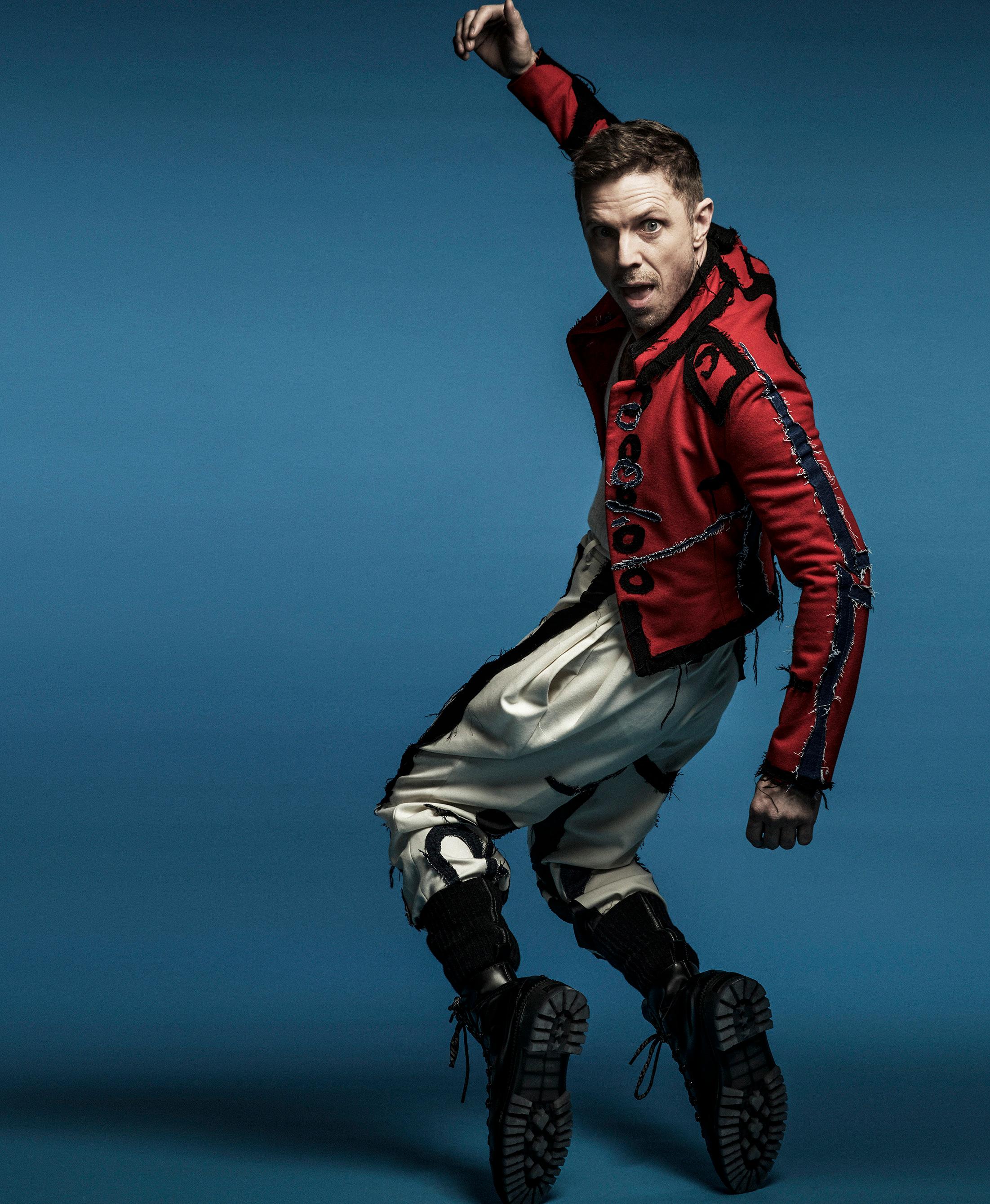
HOW BUSINESSES ARE BECOMING MORE INCLUSIVE WITH “RAINBOW REGISTERED”
OUR STORIES AND IDEAS SHOW UP IN THE MOST UNEXPECTED PLACES
1 CELEBRATING CANADA’S 2SLGBTQI COMMUNITIES MAY / JUNE 2023

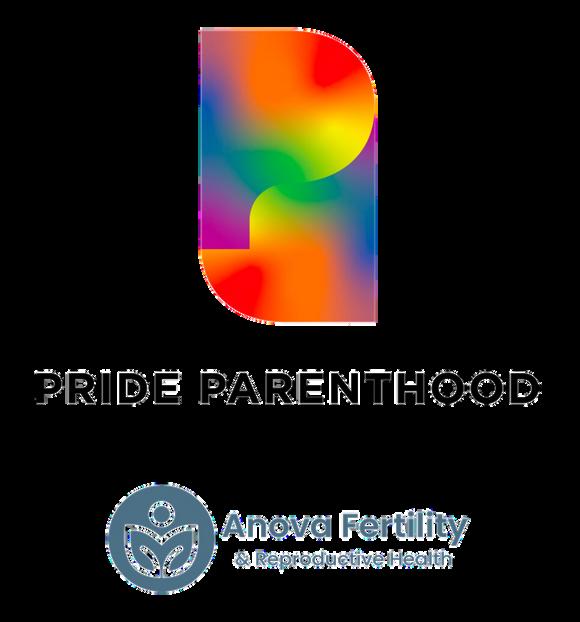
L G B T Q 2 S I + C O M P A N Y , P R O U D L Y S E R V I N G A L L P A T H W A Y S T O P A R E N T H O O D . P R I D E P A R E N T H O O D H A S P A R T N E R E D W I T H A N O V A F E R T I L I T Y , P R O V I D I N G A C C E S S T O T H E B E S T F E R T I L I T Y S E R V I C E S I N C A N A D A . A L L F E R T I L I T Y J O U R N E Y S A R E U N I Q U E . E V E R Y I N D I V I D U A L H A S T H E F U N D A M E N T A L R I G H T T O G R O W T H E I R F A M I L Y . W E W O U L D B E H O N O U R E D T O A S S I S T W I T H Y O U R S . B E G I N Y O U R J O U R N E Y T O P A R E N T H O O D N O W A T : W W W . P R I D E P A R E N T H O O D . C O M





3
CABENUVA.CA CABENUVA –an injectable treatment. Talk to your doctor. LIFE HAPPENS WHEN YOU LEAST EXPECT IT BY Trademarks are owned by or licensed to the ViiV Healthcare group of companies. ©2021 ViiV Healthcare group of companies or its licensor. Code: PM-CA-CBR-JRNA-210004-E Date: 01-2022 ViiV Healthcare ULC 75 Queen Street, Suite 1400 Montreal, Quebec H3C 2N6
Stock photo. Posed by model.
PUBLISHER

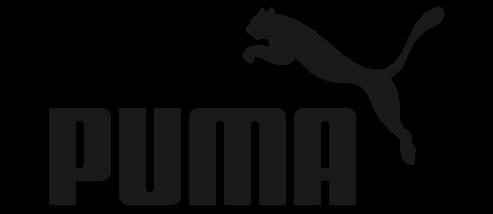
Patricia Salib
GUEST EDITOR
Christopher Turner
ART DIRECTOR
Georges Sarkis
COPY EDITOR
Ruth Hanley
SENIOR COLUMNISTS
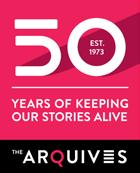
Paul Gallant, Doug Wallace
CONTRIBUTORS
Jesse Boland, Jamie Booth, Tyler Boyce, Matthew Creith, Adriana Ermter, Courtney Hardwick, Elio Iannacci, Karen Kwan, Luis Augusto Nobre, Larry Olsen, Ivan Otis, Stephan Petar, Brian Phillips, Ingrid Randoja, Warren Urquhart
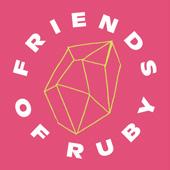
DIRECTOR OF BUSINESS DEVELOPMENT

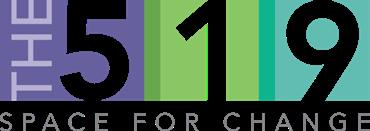
Benjamin Chafe
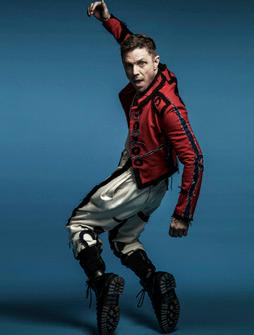
DIRECTOR OF COMMUNICATIONS AND COMMUNITY ENGAGEMENT

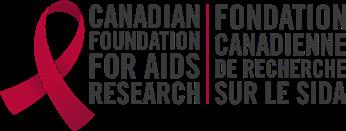


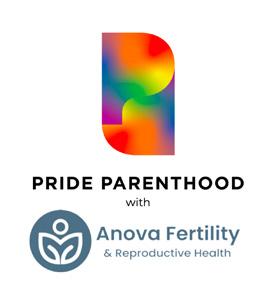
Jumol Royes
CONTROLLER COMMUNITY RESOURCE NAVIGATOR
Jackie Zhao Tyra Blizzard
ADVERTISING & OTHER INQUIRIES (416) 800-4449 ext 100 info@inmagazine.ca
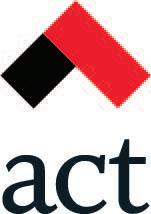
EDITORIAL INQUIRIES (416) 800-4449 ext 201 editor@inmagazine.ca
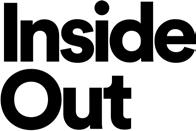
IN Magazine is published six times per year by Elevate Media Group (https://elevatemediagroup.co). All rights reserved. Visit www.inmagazine.ca daily for 2SLGBTQI+ content.
180 John St, Suite #509, Toronto, Ontario, M5T 1X5
PRESENTING SPONSOR GOLD SPONSOR
BRONZE
COMMUNITY PARTNERS
4 IN MAGAZINE MAY / JUNE 2023 inmagazine.ca
ON THE COVER: JAKE SHEARS
PHOTO BY DAMON BAKER
SPONSOR SIGNATURE SPONSOR
Issue 112
May | June 2023
INFRONT
06 | HOW BUSINESSES ARE BECOMING MORE INCLUSIVE WITH “RAINBOW REGISTERED”
Learn more about the national Rainbow Registration accreditation program, which will help 2SLGBTQI+ Canadians and allies find a business that supports the community
08 | THE ESSENCE OF BEING RAINBOW COMMUNITIES
Queer people owe a lot to trans communities and activists for their leadership in the liberation movement
10 | WEIGHT FOR IT
The five “Feel good, look good and, well, be good to your body” benefits of the weighted blanket
12 | GET MOVING
Peloton instructor Matty Maggiacomo shares his top tips for making fitness a part of your routine
14 | INTERSECTIONALITY: THE KEY TO FIGHTING HATE CRIMES AGAINST CANADA’S 2SLGBTQI+ COMMUNITIES
We can no longer accept a system that refuses to accommodate the fullness of the people it is meant to serve
15 | CASEY HOUSE’S PEER PROGRAM OFFERS SUPPORT AND RESOURCES THROUGH PRIDE AND YEAR-ROUND
We talk to Andre Ceranto about the program, which is available year-round, not just during Pride Month
FEATURES
16 | WHAT NO ONE TELLS YOU ABOUT BEING A MIDDLE-AGED GAY Embracing aging as a gay man can be an overwhelming and liberating experience
18 | PERSONAL ACCOUNTABILITY IN A TOXIC SELF-CARE CULTURE
While the practice of self-care and mental health treatment has traditionally played a vital role in human development, the contemporary culture of commercialized therapeutic treatments is problematic
20 | SERVING ALL PATHWAYS TO PARENTHOOD
All fertility journeys are unique
22 | LOVE AND MARRIAGE
Jason T. Gaffney’s new series, Marriage of Inconvenience on Dekkoo, is a family affair
24 | IT’S OPEN SEASON ON CAZDEN HUNTER
We catch up with the adult film star
26 | IS AI FACIAL RECOGNITION TRANSINCLUSIVE?
Does AI, specifically facial recognition, fail to recognize transgender people, or misgender them? And, if so…what needs to be done to fix it?
28 | SHEARS GENIUS
Jake Shears opens up on the eros and ethos behind his groundbreaking album, Last Man Dancing

32 | INSIDE OUT GIVES BACK Money talks at Inside Out.… After all, it’s more than just the movies
Read our interview with cover boy Jake Shears, who opens up about everything and anything, on page 28
33 | THE FIVE DEVILS GIVES QUEER ROMANCE AND FAMILY SECRETS A NEW PERSPECTIVE
The new French film from acclaimed director Léa Mysius takes time travel and family drama to new heights this year
36 | DANIEL BARTHOLOMEW-POYSER IS BREAKING DOWN BARRIERS…AND FEELING THORGEOUS!
We talk to the TSO’s Barrett Principal Education Conductor & Community Ambassador about presenting music in new and exciting ways, including his upcoming performance with Drag Race’s Thorgy Thor
38 | PUMA’S ‘FOREVER. CLASSIC.’ CAMPAIGN GETS A LITTLE LOVE FROM YOUNG HOLLYWOOD
Actors Angus Cloud, Caleb McLaughlin and Iris Apatow, and model Zaya Wade, are stepping into summer in style, thanks to PUMA
40 | GUESS WATCHES CELEBRATES PRIDE 2023 WITH A LITTLE SPARKLE
The fashion authority watch brand has teamed up with The Trevor Project and is showing its pride with the launch of its ‘What Makes You Sparkle’ limited edition timepieces
54 | OUR STORIES AND IDEAS CAN SHOW UP IN THE MOST UNEXPECTED PLACES
As part of its 50th anniversary, the Canada Council’s Art Bank prioritized purchasing work by diverse and previously underrepresented artists
56 | BUILDING A LOCAL LGBTQ+ TRAVEL ITINERARY WITH GRINDR
Beyond finding “fun,” Grindr’s global network of 12 million monthly users can offer local LGBTQ+ recommendations and experiences for hundreds of destinations – you just need to explore
58 | NIAGARA FALLS WEEKEND AWAY
A couple of nights riding the current in the Honeymoon Capital of the World is a barrel of fun, pardon the pun
62 | FLASHBACK: JUNE 1, 2016 IN LGBTQ+ HISTORY
Pride flag raised on Canada’s Parliament Hill for the first time
FASHION
44 | BELOVED
That first touch and stars have been exploding –in your eyes I found home….
5
112
How Businesses Are Becoming MORE INCLUSIVE WITH “Rainbow Registered”
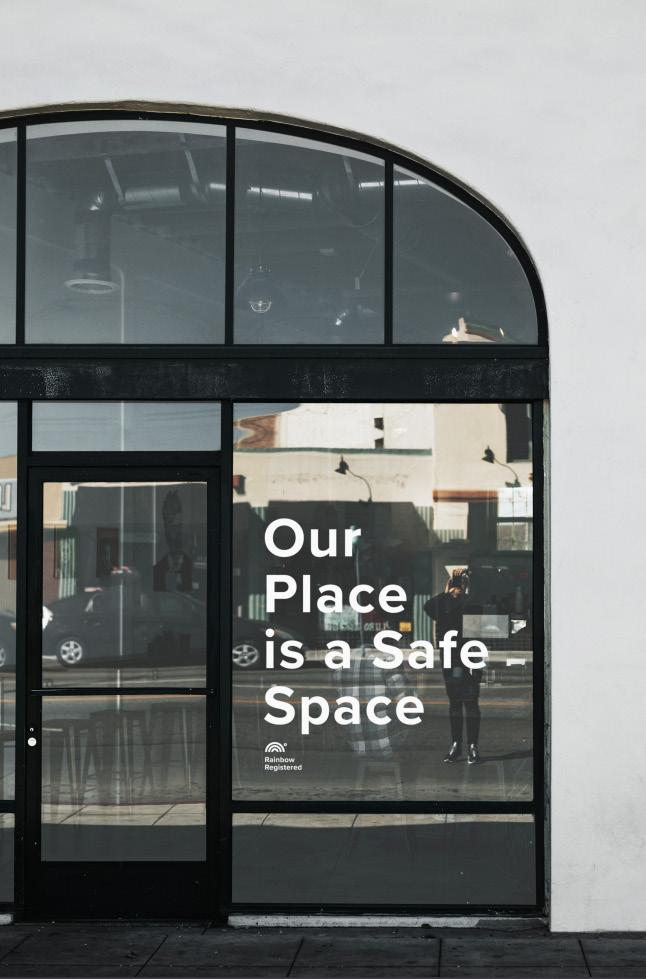 By Courtney Hardwick
By Courtney Hardwick
6 IN MAGAZINE MAY / JUNE 2023 COMMUNITY Learn more about the national Rainbow Registration accreditation program, which will help 2SLGBTQI+ Canadians and allies find a business that supports the community
A lot goes into running a successful business. In addition to managing finances and day-to-day operations, keeping customers coming back is all about building and marketing a brand that people want to support. Part of that is having a plan for how to handle a wide range of situations, including some that may be unique to customers and employees who belong to the 2SLGBTQI+ community.
Rainbow Registered is a national accreditation from Canada’s 2SLGBTQI+ Chamber of Commerce (CGLCC) designed to let 2SLGBTQI+ customers know that a business has gone the extra mile to make sure they feel safe, welcomed and accepted. When a business earns a Rainbow Registered accreditation, it means it has met a stringent set of standards that assess how a business deals with negative customer experiences, welcomes 2SLGBTQI+ employees and customers, conducts staff training, maintains inclusive leadership practices and fosters an overall culture of inclusivity.
Many businesses are building out their diversity and inclusion efforts internally, or may even have an unwritten set of standards that aren’t necessarily available to the public. But as customers become more discerning about the businesses they choose to support, an official accreditation like Rainbow Registered can provide proof that a business not only talks the talk but also walks the walk when it comes to prioritizing the needs of the 2SLGBTQI+ community.
to ensure 2SLGBTQI+ customers feel welcome and accepted. As inclusivity best practices evolve, businesses will have the support they need to adjust their practices and maintain the standards customers deserve. Rainbow Registered designation lasts three years, with annual update requirements to ensure businesses are always keeping up with their journey towards inclusion for all customers and employees.
In a tight community, reputation is everything, so the businesses that put in the work to hold themselves to the highest standards can set a positive example for other businesses to follow in their footsteps. As the world continues to make strides towards inclusivity and acceptance for all, every business has an opportunity to do its part.
Rainbow Registered allows businesses to market themselves as safe destinations for the 2SLGBTQI+ community. And with that comes a clear shout-out to consumers: no matter your gender identity, sexuality, or how you choose to express them, you’re safe here.
Rainbow Registered has developed a robust assessment process to determine whether a business qualifies for the prestigious designation. Assessors are looking for evidence that a business respects the fundamental rights and dignities of all people, fosters greater diversity and inclusion in Canada’s economy, and conducts operations with honesty, integrity and fairness.
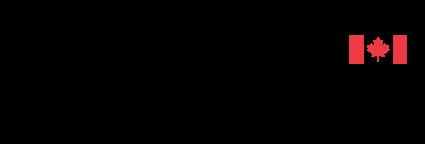

In order to fairly and thoroughly assess all types of businesses, big and small, research goes beyond formal documentation. Assessors will also consider media articles, customer reviews and statements from community partners, and conduct in-depth interviews with the owners, managers and employees, to get a clear picture. For applicants, the key is being able to demonstrate how inclusivity policies come to life and impact the 2SLGBTQI+ community in real time. Since no two businesses are alike, the assessment process aims to be flexible and open-minded.
Once accredited, businesses can continue the process and deepen their inclusivity practices with guidelines from CGLCC on how
For more information on the national accreditation program, and to find Rainbow Registered businesses in your area, visit RainbowRegistered.ca.
For more information on Canada’s 2SLGBTQI+ Chamber of Commerce, visit cglcc.ca.
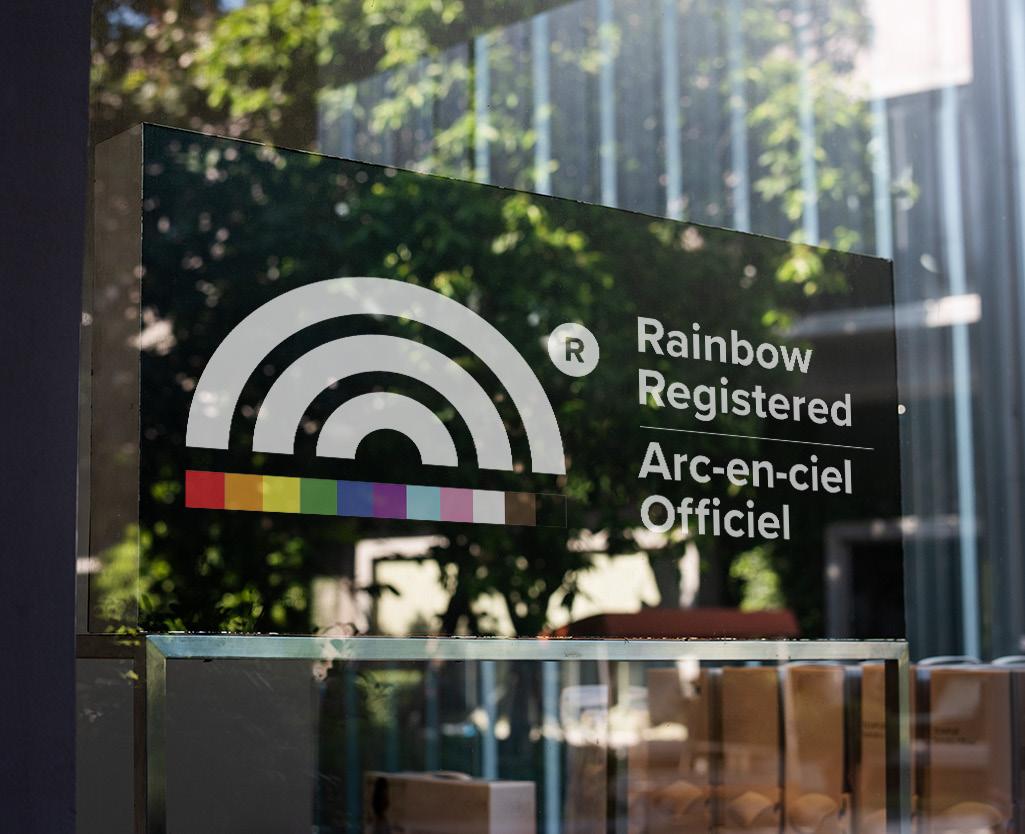
7 COURTNEY HARDWICK is a Toronto-based freelance writer. Her work has appeared online at AmongMen, Complex Canada, Elle Canada and TheBolde COMMUNITY
“Rainbow Registered is a national accreditation from Canada’s 2SLGBTQI+ Chamber of Commerce (CGLCC) designed to let 2SLGBTQI+ customers know that a business has gone the extra mile to make sure they feel safe, welcomed and accepted.”
The Essence Of Being RainBow communitiEs
Queer people owe a lot to trans communities and activists for their leadership in the liberation movement
 By Luis Augusto Nobre
By Luis Augusto Nobre
8 IN MAGAZINE MAY / JUNE 2023
PRIDE AT WORK
Photo by Raphael Renter on Unsplash
I have been reflecting on my identity and how I interact with other members of the 2SLGBTQIA+ communities. It has been getting more intense as Pride season approaches, and I witness all the movements to celebrate queer and trans people, whether by community engagement or pink-washing/rainbow-washing. This last one is not exclusive only to some brands and businesses that use the colourful approach to take our pink money – some community members also endorse the superficial practice and exclude other identities from our acronym umbrella.
We cannot deny that the majority of the campaigns and visual initiatives targeting 2SLGBTQIA+ people focus on white cis-gay men and contribute to perpetuating several stereotypes. The other letters in the acronym turn out to be less relevant or are barely mentioned. However, one group representing a significant and representative identity experiences more backlash and violence than all the other letters combined: the trans community.
The current wave of conservative and discriminatory legislation and activism in several countries, including Canada, is increasing the life-threatening risks for members of 2SLGBTQIA+ communities worldwide. This wave also includes transphobic trends in countries such as the United Kingdom and the United States. In our southern neighbour, there are almost 500 new anti-trans bills in 47 states that have targeted trans communities and created an internal diaspora. A campaign to offer asylum to queer and trans people in Canada was developed, and both the UK and the US are listed as some of the most dangerous places for trans folks.
featured in the chocolate company’s campaign. The discriminatory and hateful messages on social media that resulted from this campaign escalated to levels of physical threats…including many from our communities. Johnstone has been responding with love, and has received support from people who know the importance of visibility and recognition in promoting human rights.
For a long time, a number of individuals from the letters G and L have felt superior to the other letters in our rainbow acronym. They try to create a social media movement that excludes others based on gender identity, gender expression and sexual orientation. I have witnessed bias and prejudice against bisexual people. One example is how bisexual men face double discrimination from gay men, where their sexuality is not genuinely respected. Many are told that they are hiding and being cowards, using bisexuality as an excuse to stay in the closet. Another one is even more complex. Bisexual women experience discrimination and systemic barriers, as reflected in their pocket: a straight man pulls in, on average, twice the annual salary ($55K/year) as a bisexual woman ($26K/year).
This may be a bad comparison, but the discrimination within 2SLGBTQIA+ communities is similar to women saying they have all their rights so they don’t need feminists. It attests to the ignorance of the historical process and the fight for gender equality. The imbalance between men and women in workplaces encompassing salaries and leadership roles remains high, not to mention other aspects such as harassment and violence. The more intersectional lenses we use, the more gaps and disparities we will find.
It is why many members of our 2SLGBTQIA+ communities end up living and working in unsafe spaces or underemployment –because the behaviours of some folks endorse discrimination and harassment. They have to hide aspects of their lives to reduce the received harm, and in the hope they can remain invisible to bullies. Although this is an ordinary reality, some not only come out but also open up so that others can thrive. Their decisions positively impact business and entrepreneurship because they spread awareness about diverse identities and pursue a sense of belonging.
Queer people owe a lot to trans communities and activists for their leadership in the liberation movement, including the famous Stonewall Riots in 1969. The three key names from the rebellion against oppression aren’t from the G communities. Trans icons Stormé DeLarverie, Marsha P. Johnson and Sylvia Rivera are considered the leaders of that June 28 event, when queer and trans people fought for their rights against the New York Police. Many of us don’t remember or recognize all the advances in protecting our rights that have been gained by trans activists, who have been experiencing hate and are responding with love for themselves and others.
One great example of our lack of memory is related to the 2023 Hershey’s Her For She campaign, associated with International Women’s Day. Fae Johnstone, a trans activist and the executive director of Wisdom2Action, was one of the five young leader women, all of whom are engaged in social impact initiatives, who were
When we say that trans rights are human rights, we want to highlight all the necessary steps to ensure that trans individuals are safe and protected under the law and best practices. We want to celebrate them and admire their beauty, wisdom and leadership. They are some of the most vulnerable people at the same time as we see their courage, love and willingness to live their authentic selves. Our queer history is full of examples: the above-mentioned Stonewall is just one.
So, dear member of the letters G and L, next time you might think about not recognizing the importance of the other letters of our acronym – especially the letter T – be aware that we owe them the freedom, liberation and rights we have all gained so far. They are walking with a target on their backs, and we have a duty to protect them wherever and whenever we are, even if they aren’t in the room. Be inspired by the poem “First they came ...” by the German Lutheran pastor Martin Niemöller (1892–1984), which also inspired the German playwright and poet Bertolt Brecht: “Then they came for me, and there was no one left to speak out for me.”
9
PRIDE AT WORK
LUIS AUGUSTO NOBRE is the senior communications coordinator of Pride at Work Canada/Fierté au travail Canada, a leading national non-profit organization that promotes workplace inclusion on the grounds of gender expression, gender identity and sexual orientation. For more information, visit prideatwork.ca.
“Queer people owe a lot to trans communities and activists for their leadership in the liberation movement, including the famous stonewall riots in 1969.”
Weight For It Weight For It
By Adriana Ermter

10 IN MAGAZINE MAY / JUNE 2023 HEALTH &
WELLNESS
The five “Feel good, look good and, well, be good to your body” benefits of the weighted blanket
Photo by Dex Ezekiel on Unsplash
“It might seem crazy what I am ’bout to say Sunshine, she’s here, you can take a break I’m a hot air balloon that could go to space With the air, like I don’t care, baby by the way Huh (Because I’m happy)
Clap along if you feel like a room without a roof
(Because I’m happy)
Clap along if you feel like happiness is the truth
(Because I’m happy)
Clap along if you know what happiness is to you
(Because I’m happy)
Clap along if you feel like that’s what you wanna do”
Pharrell William’s “Happy” lyrics are so energetic that if he told us he’d sung them following a good night’s sleep beneath a weighted blanket, we wouldn’t be surprised. According to a 2018 study published by the US National Library of Medicine, 63 per cent of adults reported lowered anxiety after lying under a 30-lb. weighted blanket for just five minutes – which explains why the experts at the Sleep Foundation say the boost of serotonin (the “happy hormone”) that you’ll get from a weighted blanked can be likened to a big hug from someone you trust and love.
The heavy blankets are not newbs; they were originally introduced in 1999 by occupational therapist Tina Champagne as a deep pressure therapy treatment used to regulate emotions and to induce feelings of well-being and calm. But with the launch of the Gravity Blanket on Kickstarter approximately seven years later – coupled with their gain in notoriety courtesy of Instagram posts by A-listers such as Jillian Michaels, Tom Brady, Kourtney Kardashian and Jordan Rodgers – the bamboo, cotton, linen, flannel and rayoncrafted blankets have only grown as a must-have item in recent years. These five health and aesthetic benefits may convince you that a weighted blanket is right for you. (That said, should you have a medical condition such as type 2 diabetes, claustrophobia, or chronic circulatory or respiratory issues including asthma, the Sleep Foundation recommends speaking with your doctor before crawling under a weighted blanket.)
Health benefit #1:
Health benefit #1: PROMOTES DEEP SLEEP
In Canada, according to ongoing research conducted for and by Hush Blankets, 25 per cent of adults across the nation claim they have trouble falling asleep or staying asleep the majority of the time. Weighted blankets are believed to combat your sheep-counting struggles that contribute to insufficient sleep by easing anxiety and calming your heart rate to ensure you fall into a deep sleep. Using deep pressure stimulation, the blankets (which typically range in weight between five and 30 pounds courtesy of their sand, rice, microfibre bead, metal bead and bamboo-fillers) put your autonomic nervous system into rest mode, increasing your levels of melatonin, known as the sleep hormone.
Health benefit #2:
Health benefit #2: RELIEVES ANXIETY SYMPTOMS
Thanks to issues like global warming, unstable political and economic climates, and so much more, anxiety is now a common mental health disorder. In fact, according to the World Economic Forum, approximately 275 million people globally suffer from anxiety. Some of its symptoms include a fast heart rate, quick breathing, hyperactivity and shortness of breath, and these are said to be relieved by distributing an even amount of weight across the entire body, which weighted blankets can provide. This weightier sensation is believed to reduce the body’s fightor-flight response when feeling agitated and can, according to the Sleep Foundation, promote feelings of happiness and relaxation.
H ealth benefit #3:
H ealth benefit #3:
LOWERS
YOUR STRESS RESPONSE
Having an overactive sympathetic nervous system can contribute to obesity and kidney disease, say the experts at Hush Blankets. They believe that the deep pressure stimulation from resting, napping and sleeping under a weighted blanket can calm your nerves and lower your physiological stress levels.
H eath benefit #4:
H eath benefit #4:
EASES PAIN AND DECREASES CORTISOL LEVELS
While the experts at the Sleep Foundation attribute the weighted blanket’s deep pressure benefits to increasing serotonin production and lowering cortisol (the stress hormone that has been linked to health issues including heart disease, weight gain and high blood sugar), it can also diminish pain. A 2021 study by the National Library of Medicine found that sleeping with a weighted blanket can reduce pain and ease chronic pain symptoms, which, according to Health Canada, are experienced by nearly eight million Canadians.
Health benefit #5:
Health benefit #5: BOOSTS YOUR MOOD
Possibly our favourite benefit of all is that in addition to the benefits of improving mental stress and easing pain, weighted blankets can act as a mood booster. Due to the pressure of the weighted blanket, your body increases its production of oxytocin, the feel-good hormone. Combined with the decrease in cortisol, this works to improve your overall mood. And when you feel better, you look better and you do better. Period.
11 HEALTH & WELLNESS
ADRIANA ERMTER is a Toronto-based lifestyle-magazine pro who has travelled the globe writing about must-spritz fragrances, child poverty, beauty and grooming. Z
Z
Z Z Z Z Z Z
GET MOVING
Peloton instructor Matty Maggiacomo shares his top tips for making fitness a part of your routine
By Karen Kwan
We all know we should be keeping active daily, but finding that motivation and getting off the couch can be challenging some days. So how can you face each workout with a positive attitude?
We checked in with Peloton instructor Matty Maggiacomo for his expert tips. As someone who didn’t grow up loving fitness but is now one of the world’s top trainers (and he’s got a super optimistic outlook, too), Maggiacomo’s got the insight that’ll get you on your way to a balanced, healthy active lifestyle.
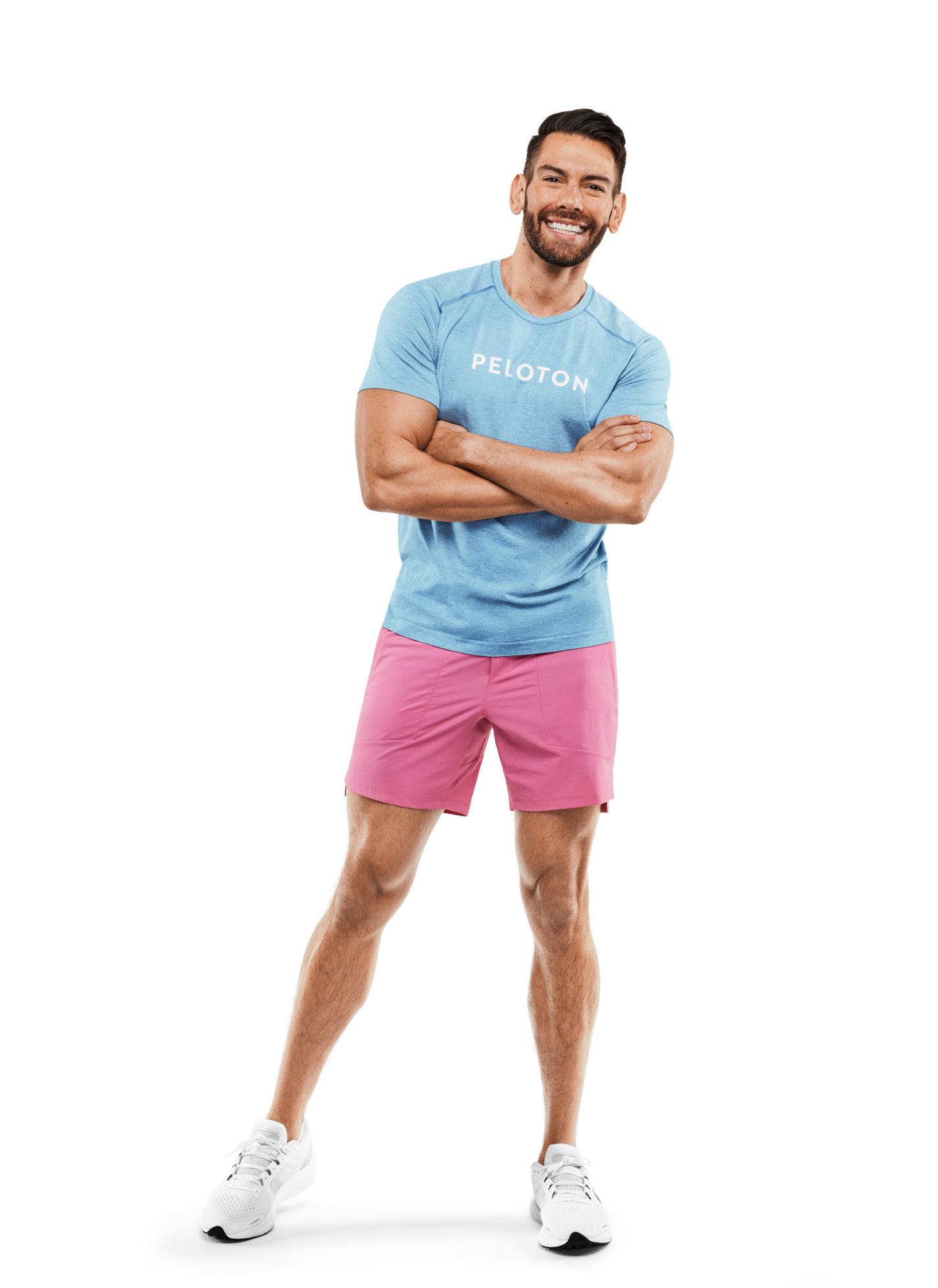
How to get off that couch to work out
When you’d rather watch the next episode of Succession rather than change into fitness gear and hit the gym, taking that step can feel insurmountable. Maggiacomo says he thinks there are two types of people: the folks who are innately athletic and just love to do it, and the people who need to train both to actually do it and to learn to love it. “It’s like learning a new language,” he says. And, he adds, you need to find what you love. “If you didn’t love eating broccoli, why do you eat broccoli every day? Nobody’s gonna do that!” Maggiacomo recommends trying different sports and activities until you find what you love. “We often think we need to suffer or hate it in order to excel, but you just need to find your path.”
How to cross-train when you only love one type of workout
You’ve found the workout you love, but we all know it’s important to cross-train. When it comes to incorporating the workouts you’re not fond of, Maggiacomo says it’s all about dipping your toe into these other types of fitness. Explore other activities and take your time with figuring it out, he says. “Sometimes it might be a really good instructor.” Perhaps you tried hatha yoga with one teacher and found it dull; another instructor might make all the difference for you. Maggiacomo says you have to tap into that perseverance to establish a foundation. “Maybe you’re not stretching right after a run, but you can do a few stretches before going to bed, for example,” he says.
How to make sure you work out on a regular basis
Find an accountability partner. Even Maggiacomo has a few accountability partners. “Find somebody you really love to work out with. ‘Tomorrow morning, we are waking up and we are going to run together!’” he says. He says encouraging each other is a great way to set both of you up for success. He also recommends having your workout clothes and shoes ready so you’re staring at them as soon as you wake up. He admits he feels guilty if he’s looking at the Peloton hardware at home and not using it. One of Maggiacomo’s accountability partners? His mom. “She’s always asking me when I’m working out!”
How to keep your body happy
You can take rest days. There are days Maggiacomo just isn’t feeling like working out. “I listen to my body and I take a full day. You need to have your rest days!”
How to make workouts interesting
You might find you’ve fallen into a rut with your fitness. Keep trying new workouts to keep things interesting – Maggiacomo says trying a workout at home can be an easy way to discover new-to-you classes. “I didn’t know I liked barre until I took barre classes on Peloton. Before, I wouldn’t have gone to a barre class on my own, but now that I know what it’s all about, I would totally go on my own,” he says.
12 IN MAGAZINE HEALTH & FITNESS
KAREN KWAN is a freelance health, travel and lifestyle writer based in Toronto. Follow her on Twitter @healthswellness and on Instagram @healthandswellness.


13 We Help Elevate Brands And The Communities They Serve. Authentic LGBTQ2+ marketing grounded in purpose. Welcome Elevatemediagroup.co
INTERSECTIONALITY: THE KEY TO FIGHTING HATE CRIMES AGAINST CANADA’S 2SLGBTQI+ COMMUNITIES
By Tyler Boyce
According to data released by Statistics Canada earlier this year, police-reported hate crimes targeting 2SLGBTQI+ communities have increased by 64 per cent since 2021 – a record high increase. As Canada continues to grapple with a growing wave of hate crimes, particularly against marginalized communities, it has become increasingly clear that a multi-faceted approach is needed to tackle this issue. One key element of this approach is intersectionality, an idea that has gained significant traction in recent years within Canada’s 2SLGBTQI+ movement and beyond.
When people visualize Canada’s queer movement, they often imagine white, cisgender, able-bodied, high-income men. This picture is also held by policy-makers, philanthropic foundation leaders and unions – and it results in progressive movements being unequipped to support Canada’s 2SLGBTQI+ movement at a time when we need them most.
I am not only the executive director of the Enchanté Network, Canada’s largest network of 2SLGBTQI+ organizations, but I am also a Black queer person – and my vision is one of progressive movements where no one is left behind.
Intersectionality is a concept coined by Dr. Kimberlé Crenshaw that recognizes the complex interplay of different forms of oppression, including those related to race, gender, sexuality, religion and ability. It acknowledges that people experience these forms of oppression simultaneously and that these experiences are interconnected.
A heightened risk of experiencing hate crimes
Intersectionality is particularly important in the context of the 2SLGBTQI+ community, as many individuals identify with multiple marginalized identities. For example, a queer or trans person may also be Black or Muslim, which can compound their experiences of discrimination and prejudice – and heighten their risk of experiencing a hate crime.

In recent years, there has been a growing awareness of the importance of intersectionality in the fight against hate crimes targeting Canada’s 2SLGBTQI+ communities. As hate crimes against this community continue to rise, it has become increasingly clear that these crimes
intersect with growing hate crimes against Black and religious communities, who are also part of the 2SLGBTQI+ community. In the same data released by Statistics Canada this year, we saw hate crimes targeting religion and race also spike.
For example, in the wake of the deadly shooting at a Quebec City mosque in 2017, there was a significant increase in reported hate crimes against Muslim individuals, including those who identify as LGBTQI+. Similarly, during the pandemic, there has been a surge in anti-Asian hate crimes, which also impact queer and trans Asians.
Urgent need for a coordinated approach
This intersectionality highlights the urgent need for a coordinated approach to tackle hate crimes against all marginalized communities. This approach must recognize the interconnectedness of these issues and work to address them in a comprehensive manner.
One key step in this direction is to ensure that intersectionality is integrated into all aspects of Canada’s 2SLGBTQI+ movement. This includes advocating for policies and programs that are inclusive of all marginalized communities, as well as fostering dialogue and collaboration between different communities and organizations. This is why the theme of the Enchanté Network’s upcoming annual conference this fall is ‘coalition building.’ We can no longer accept a system that refuses to accommodate the fullness of the people it is meant to serve.
Another important step towards embedding intersectionality into our collective approach to combatting hate crimes against queer communities is to prioritize the voices and leadership of those who are most impacted by hate crimes. This includes Black and religious queer and trans individuals, who have been at the forefront of intersectional activism in Canada.
As we continue to grapple with the devastating impact of hate crimes in Canada, it is crucial that we recognize the importance of intersectionality in the fight against all forms of oppression. By working together, we can build a more just and inclusive society for all – not just those who most mirror what power already looks like in this country.
14 IN MAGAZINE MAY / JUNE 2023 ADVOCACY
We can no longer accept a system that refuses to accommodate the fullness of the people it is meant to serve
TYLER BOYCE is a nationally recognized human rights activist and the executive director of the Enchanté Network, Canada’s largest network of 2SLGBTQI+ organizations. He is also an adjunct professor in the University of Ottawa’s Faculty of Law, where he teaches Deconstruction of Racism in the Law. His leadership is grounded in Black Queer Feminist Thought, Queer Theory and a commitment to bridging the worlds of research, public policy and social justice.
CASEY HOUSE’S PEER PROGRAM OFFERS SUPPORT AND RESOURCES THROUGH PRIDE AND YEAR-ROUND
We are officially headed into another season full of Pride! Typically, Pride brings increased awareness to HIV and other STIs, including the resources available to support those who have been diagnosed or are at risk.
Casey House, which opened in 1988 in Toronto at the height of the HIV/AIDS epidemic, is a small specialty hospital – Canada’s first and only hospital for people living with or at risk of HIV. Their inpatient unit features 14 private rooms and a team of dedicated healthcare professionals providing 24-hour care. There’s also an outpatient program that runs Monday through Friday, as well as an outreach program and drop-in clinic.
We sat down with Andre Ceranto, who is extremely active in the HIV community, previously holding roles at Toronto People with AIDS Foundation, Fife House Foundation and AIDS Committee of Toronto. Ceranto has been Casey House’s peer program manager since late 2018, focusing on supporting HIV-positive folks and their health by connecting them to needed services.
How does Casey House support the people living with HIV (PLHIV) community in Toronto and, more broadly, in Canada?
We recognize a person’s physical, mental, cultural and social wellbeing as fundamental components of wellness. In addition to a 14-bed inpatient unit for people requiring 24/7 medical care, there is a robust outpatient program for people who can benefit from a range of health services and social supports. Through individual appointments and facilitated groups, an interdisciplinary clinical team builds relationships through a harm reduction approach. In 2021, Casey House opened Ontario’s first hospital-based supervised consumption service for clients who use substances. Building on a legacy of advocacy and social justice, Casey House works to actively dismantle barriers to care and safe living.
What is the Peer Program? What are the goals or objectives of the program?
At Casey House, peers are individuals living with HIV or with experience of substance use who are trained to support others by sharing their own lived experience. Peers are integrated into Casey House’s client care team to support clients as they work to attain their health and wellness goals. Embedding the wisdom of lived experience into the care team strengthens Casey House’s commitment to GIPA/ MEPA [Greater Involvement of People Living with HIV and/or AIDS/ Meaningful Engagement of People Living with HIV and/or AIDS].
In both the inpatient unit and outpatient services, individuals with lived experience are matched with clients who could benefit from additional one-on-one support. Each peer works directly with one client to assist with different aspects of living with HIV. Peers build relationships with clients not by telling them what to do or not do, but by sharing their personal experience.
Why is peer support particularly important for those navigating an HIV diagnosis?
Peers have been there. They can utilize their experience to support others dealing with a lot of the same issues. Sometimes they can
prevent other folks from going through the hardships they had to go through in accessing support and finding information.
Based on your experience, how might Pride impact someone navigating a new diagnosis, struggling to access care or dealing with social isolation?
Usually around Pride, there is an increased awareness about HIV and other STBBI testing, so it is a good time to have a message to those who have recently tested positive for HIV. Pride provides an opportunity to remind those recently diagnosed of the importance of getting connected to care as soon as possible; and that there are many resources available, including people with lived experience who can support those who are newly diagnosed with accessing information, finding resources, connecting them with support services and lending an ear as someone who has experienced the same news of a positive HIV diagnosis.
Why is Pride the right moment in time to highlight the supports available to the PLHIV community?
When I think about folks who have lived with HIV/AIDS for a very long time, it makes me reflect and think. For many of us, PRIDE is a time to celebrate diversity, celebrate our community(ies), be happy and have fun; but for others – including people living with a chronic illness such as HIV – taking part in the celebrations may not be possible for health reasons; for some it could also be triggering or isolating; and for others it could make them self-conscious about their limitations imposed by their health condition. So, for me doing this work, Pride is a time to reflect and be mindful of those who came before us and paved the way, so we could have the freedom, acceptance, and quality of life we enjoy today.
As a community we need to be reminded, especially during that time, to be kind and take care of one another, just as peers do. Pride Month is also a great opportunity to invite those who are living with HIV and are fortunate enough to be in good health and enjoying some stability in their lives, to consider applying to become a peer worker and contribute to their community by utilizing their lived experience to support others. I can personally attest that peer work is very empowering. It also brings a lot of satisfaction, and is a great opportunity for personal growth.
How can people learn
more about the program and/or apply to become a peer?
Casey House’s structured program builds peer capacity to support clients and provides opportunities for peers to debrief and reflect on their work with clients. Peers are paid an honorarium for their work, and attention is also paid to their own health and wellness. For those who feel they can use their lived experience to help others, consider joining a peer program and giving back to the community. To learn more about the Peer Program and/or apply to be a peer at Casey House, visit https://caseyhouse.ca/our-approach/ integrating-lived-experience/peer-support.
Casey House offers a variety of patient programs for folks of all backgrounds. For a 2023 calendar, visit caseyhouse.ca/our-health-services/outpatient-day-health.
15
COMMUNITY
We talk to Andre Ceranto about the program, which is available year-round, not just during Pride Month
WHAT NO ONE TELLS YOU ABOUT BEING A MIDDLE-AGED GAY
Embracing aging as a gay man can be an overwhelming and liberating experience
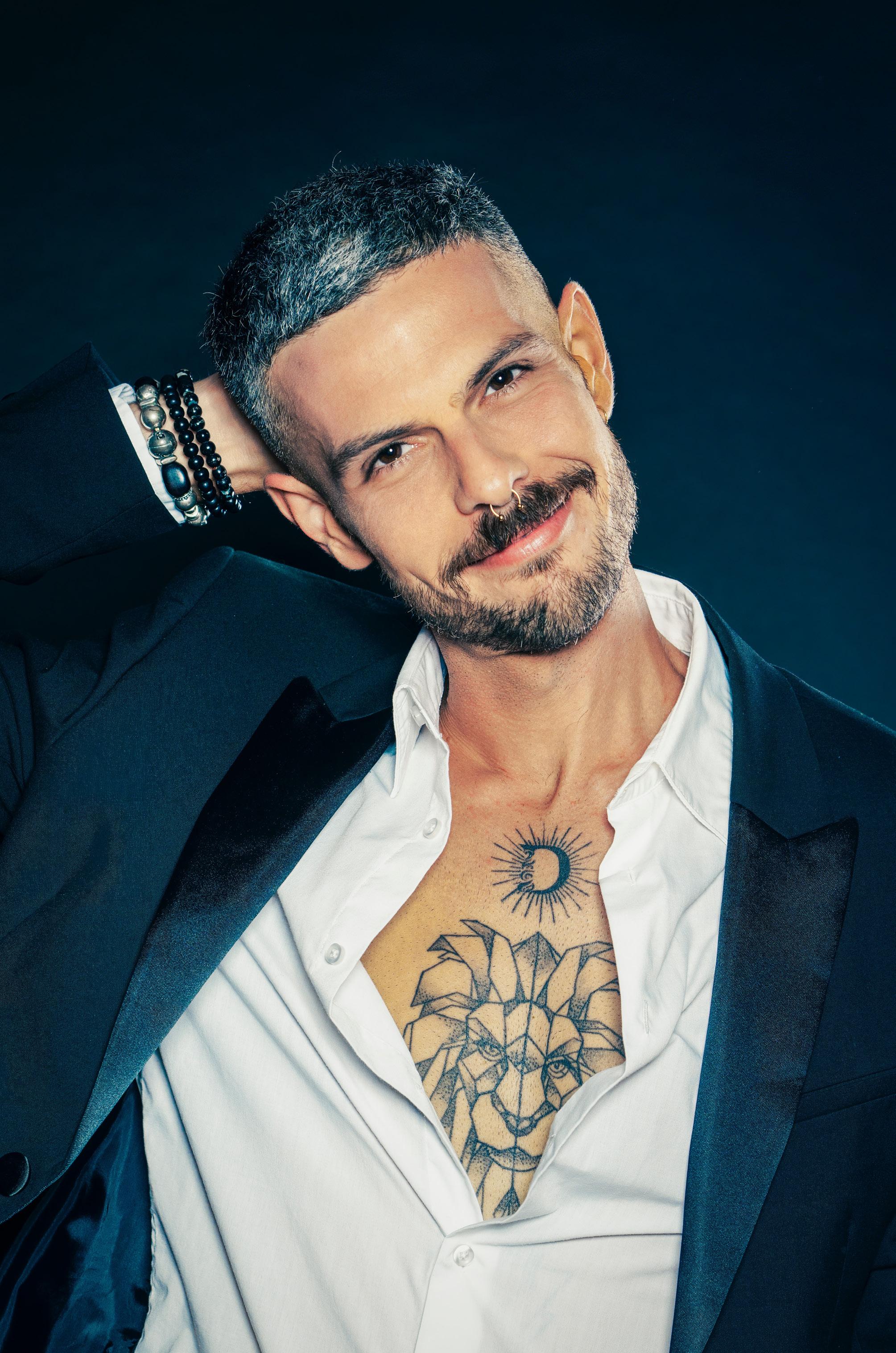 By Jumol Royes
By Jumol Royes
16 IN MAGAZINE MAY / JUNE 2023
Photo by Christian Buehner on Unsplash
PERSPECTIVE
Gay culture is youth obsessed. That’s not breaking news. Like it or not, we are a youth-obsessed community.
Yet not even the gay glitterati have figured out how to stop the biological clock and put a halt to the aging process.
I turned 40 recently and was forced to reckon with the great expectations this birthday is burdened with. After remembering that birthdays are simply temporal markers that we use to remind ourselves, and each other, that we’re still here taking up space, I got to thinking about all the things no one tells you about becoming a middle-aged gay man.
For starters, you don’t receive an email or phone notification reminding you to change your Grindr tags and tribes from twink, twunk or cub to bear, daddy or zaddy, for those of you with a little extra swagger in your step.
Planning to meet up for drinks with a guy from the dating app? Be prepared to possibly spend more money than you accounted for when you discover that you’re not only responsible to pay for your own drinks, but to cover the tab of the hottie you’re hoping to hook up with. Cue Carrie’s prophetic words of wisdom from the first Sex and the City movie: “Enjoy yourself. That’s what your 20s are for. Your 30s are to learn the lessons. Your 40s are to pay for the drinks.”
There’s no gay guidebook that tells you the right age to add a retinol cream to your skincare routine – instead of waiting until your 30s or 40s, some beauty experts encourage starting in your 20s – or to help you decide whether anti-wrinkle injections, dermal fillers or more invasive procedures are right for you.
A visit to the dermatologist’s office leading up to my birthday revealed that my skin is in good condition (thank you genetics), but that I should consider upgrading my moisturizer and using a daily sunscreen. Despite what you may have heard, darker skin needs protection from the sun, too. The doctor also suggested Botox for that stubborn fine line on my forehead that doesn’t appear to be going anywhere. Not quite ready to brave the needle, I opted for a HydraFacial instead.
But wait…there’s more! Get ready for a slower metabolism, weight gain and your first strands of grey hairs sprouting from your head, nose, beard and, dare I say it, below the waist. Good times.
Beyond the superficial considerations that come with aging while gay lie deeper issues that cut straight to the heart of the matter.
There’s the shame that sometimes creeps up when you’re perpetually single, and the nagging fear that you’ll never find the right partner. Or there’s the stress of keeping the spark alive if you’re coupled and considering creative options like an open relationship.
Partnered or not, you’d be hard-pressed to find many gay men who are willing to talk openly about the feelings of loneliness they wrestle with as they age. Don’t let the silence fool you: the epidemic of gay loneliness is real and can fuel anxiety, depression and suicidal ideation.
In a culture that tends to devalue you if you’re not young and popping, how are mature gay men supposed to deal with waking up one day and suddenly realizing that they’re invisible and irrelevant within their own community?
It’s not all gloom and doom, though. Being a middle-aged gay has its benefits.
At a certain age, you start to become more comfortable in your own skin and gain a newfound sense of confidence and inner peace. There’s less to prove to anyone else but yourself. You might even try embracing the mantra: This is who I am. Take it or leave it. Love it or hate it. How many fucks do I give? None.
You also realize that aging is a privilege many gay men in previous generations were never afforded. The early days of the HIV epidemic played a pivotal role in gay culture’s current obsession with physical appearance. Looking fit was a way for gay men who carried the virus not to be seen as sick. HIV/AIDS robbed too many of these men of their futures in what should have been the prime of their lives. Just a little perspective for the next time you find yourself downplaying your age.
Perhaps the best part about being gay and aging gracefully is that you get to redefine what aging as a gay man looks like for you. That requires courage and rejecting heteronormative expectations like getting married, having kids and owning one or multiple properties, and the problematic youth-centric attitudes that permeate the LGBTQ2+ community. Sounds pretty liberating to me.
If you haven’t yet heard of the Old Gays, you’re missing out. This foursome of gay men, who range in age from their mid-60s to their late 70s, share a beautiful bond of friendship and have become social media stars in recent years on account of their viral videos. Seeing them enjoying life and having fun should give hope to gays of all ages.
In an interview on the Today show in 2021, Jessay Martin, one of the group’s members, revealed: “I have cried, and they have been tears of joy. It’s like we seem to be making a difference in these young people and to some older people, as well. They’re feeling good, too. It’s a win-win for them, a win-win for us.
“Old gays are really no different than younger gays,” he added. Well said.
17 PERSPECTIVE JUMOL ROYES is IN Magazine’s director of communications and community engagement, a GTA-based storyteller and glass-half-full kinda guy. He writes about compassion, community, identity and belonging. His guilty pleasure is watching the Real Housewives. Follow him on Instagram @jumolroyes.
“ THIS IS WHO I AM. TAKE IT OR LEAVE IT. LOVE IT OR HATE IT.”
Personal Accountability In A Toxic Self-Care Culture

While the practice of self-care and mental health treatment has traditionally played a vital role in human development, the contemporary culture of commercialized therapeutic treatments is problematic
By Jesse Boland
I understand that you are healing your inner child, but can you please clean your dishes in the sink?
The last week of December is always my least favourite time of year. Not just because of the awkward limbo period between Christmas and New Year’s or the birthing of a new generation of Capricorns entering the world to create misery, but rather the influx of self-affirming posts from people vowing to put themselves first and practise limitless self-care in the new year. Now, I mean this in the least harsh way possible when I say that there is no fucking way all of you bitches are just too selfless and giving. Like, you would genuinely have to be an agent of Cthulhu to look at the current state of our world and think, ‘You know what? There is simply too much generosity and selflessness in this world – I think people should actually be more selfish!’
It is no surprise that this sense of urgent self-importance has become the norm over recent years: many of us were already dealing with lingering sentiments of abandonment and loneliness long before COVID forced us into isolation. Yet, rather than viewing this pandemic of loneliness as a call to extend kindness to our loved ones in need, the reverse has happened and we have become more selfish than ever before as a perceived necessity to survive. While independence and self-reliability are indeed attractive attributes, the idealization of hyper-independence does perpetuate a violent, capitalist mindset designed to dissolve community and further ostracize ourselves from each other, all in the name of “self-care.”
The concept of self-care and selfishness are often perceived as being synonymous, with the former being the more positive euphemism and the latter being a negative dysphemism, but that is not entirely
18 IN MAGAZINE MAY / JUNE 2023 SELF-CARE
Photo by Nik Shuliahin on Unsplash
correct. Rather, the two often work as the overlapping circles of a moral Venn diagram used to navigate the justification of our actions, with many things more often than not falling in the centre. Not going out to the club with your friends because you’re trying to save money and need a break from drinking would qualify as self-care, but cancelling dinner plans with a friend at the last minute because you’re kinda tired is pretty whack and would likely fall under selfishness. Skipping out on your friend’s birthday party because your ex is gonna be there and it’ll be awkward? That falls into the in-between area where there is some merit to your reasoning…but that doesn’t mean your friend doesn’t have the right to be pissed at you. Not all acts of self-interest are necessarily acts of Audre Lorde–approved self-love: sometimes you’re prioritizing yourself above others just because you feel like it. That isn’t intrinsically a bad thing, but it’s good to be mindful of just how often you put yourself before others before they decide you’re better off alone.
What so much of toxic self-care culture boils down to is our use of language and the associations we attach to certain terms to reframe our way of thinking. This is a staple of many mental health practices such as cognitive behavioural therapy and self-affirmation theory, which can indeed be extremely useful for navigating harmful thoughts and emotions. The problem becomes when this method of thinking divorces individuals from feelings of guilt, remorse and shame for their harmful actions, and absolves them of all accountability for their shitty behaviour. For instance, one example of “healthy” rephrasing of thoughts is when you are late for meeting someone and, instead of apologizing by saying, “I’m sorry for being late,” you’re grateful and say, “Thank you for waiting for me.” Now listen: if you keep me waiting for 45 minutes sitting alone at a coffee shop and, upon finally arriving, instead of having the basic decency to apologize for wasting my time you commend me for being a schmuck, just know that both of our names will be on the news the following morning. There is a substantial difference between acknowledging your mistakes and imperfections without beating yourself up over it versus embracing your indecent behavior with the expectation that others should simply deal with it.
It cannot be stated enough: nobody is perfect (even Beyoncé is featured on an Eminem song). Yet the understanding that perfection is an unachievable myth does not mean we shouldn’t still aspire to better ourselves and change whatever personal flaws are within our control. The excuse that “nobody’s perfect” is somewhat of a cop-out to divorce ourselves from the responsibility for our shitty behaviour. Chew with your mouth open? Nobody’s perfect! Overfamiliarly rude with total strangers? I’m a work in progress! Kicked a homeless person? Even diamonds started off as coal! There is a tremendous difference between recognizing our own imperfections that make us human yet refusing to allow them to define us versus simply shrugging off all valid criticisms of our abhorrent habits because “haters gonna hate.” Yet as we are continuously told to never feel bad about our flaws, these once unfortunate mistakes can swiftly become indicative of a rotten disposition.
While failure is an integral step in the path towards success and we do learn our best lessons from our mistakes, there is a bizarre mindset today that fucking up is fundamental to our progression while ignoring whoever is harmed along the way. Last year, I got into an argument with one of my followers on Instagram over a story
he had told on Canada Day regarding the topic of decolonization. When I pointed out to him his mild hypocrisy given that he had several months ago vacationed in Hawai’i – a not-too-long-ago colonized land whose indigenous populations have been begging tourists to stop visiting given the devastating impact COVID has had on them as well as their water being diverted from native communities towards tourism spots – he maturely acknowledged that he was wrong for doing so, but that he did not know better at the time and had learned from his mistake. However, what didn’t sit right was his insistence that he did not regret vacationing there, and was in fact glad he had made the trip as he framed it as a learning opportunity. His beach Speedo pics from the trip were on proud display on his grid while he was conversing with me.
What his rhetoric argued was that making unwise decisions that harmfully impacted the lives of others was ultimately justified given that in the end he learned a valuable lesson to pass along to others. In his eyes, his own personal learning experience superseded the lived experiences of others, as it was a necessary step needed for his own progression. That’s a mindset we commonly hear in stories of self-improvement: the guy who learned to respect women after mistreating his romantic partners for years; the high school bully who grew up to be a guidance counsellor; Clint Eastwood in the third act of every movie learning that people of colour actually are people…after having called them every slur known to man (and woman!) for the first 90 minutes.
When we reflect on the mistakes we have made in our journeys of enlightenment, it’s vital to acknowledge that not all of our growing pains were just our own pain but also that which we have caused to others.
Hyper-individualism is killing us, and I am not being hyperbolic. For those of us who do not have the wealth or the health to take care of ourselves at all times, who are we to turn to in our moments of need if not our community?
Therapy may be lifesaving for many individuals, but it is ultimately a transactional industry that runs on consumer demand and monetary exchange wherein patients (or clients, depending on how one chooses to look at it) may quit at any time if they are not satisfied with the uncomfortable nature of the practice, and may be dropped by the practitioner if they can no longer afford to receive such treatment. As bell hooks wrote, “When we face pain in relationships our first response is often to sever bonds rather than to maintain commitment.” These words ring true now more than ever in a time where we may hire someone to validate our feelings for an hour and cut off anyone that we label as “toxic” for making us not feel good. While therapy is essential for the mental health of many, it is still no substitute for the camaraderie of our families and communities, who hold us lovingly in their arms while also holding us accountable for our bullshit.
Sometimes we need to heal, and sometimes we need to suffer the consequences for our reprehensible behaviour with the understanding that forgiveness is never owed. There is no right way to be a good person in the same way there is no way to be perfect, and all that we may do is the uncomfortable work of trying to help each other instead of telling each other to “get help.”
19
SELF-CARE
JESSE
BOLAND is that gay kid in class who your English teacher always believed in. He’s a graduate of English at Ryerson University (now Toronto Metropolitan University) who has a passion for giving a voice to people who don’t have data on their phones and who chases his dreams by foot because he never got his driver’s licence.
Serving All Pathways To Parenthood
All fertility journeys are unique
Starting a family is an exciting and life-changing time. But many LGBTQ+ individuals and couples don’t know where to turn, or lack education and resources, making this exciting journey incredibly overwhelming. Variation in clinical practices and commitments to LGBTQI+ family creation, and limited funding opportunities, are just some of the obstacles that individuals and same-sex couples have to navigate on the journey towards parenthood. Thankfully, in Ontario, a new service has been created to make that path a little easier: Pride Parenthood.

Pride Parenthood was created with the goal of making the journey to parenthood attainable. Founded on the principles of equity and inclusivity, the service removes barriers and provides access to best-in-class fertility services for the LGBTQ2SIA+ community community – growing a legacy for future generations. No one has ever established a fertility treatment referral service for gay people before because the approach to building family in fertility clinics has been geared to the heterosexual community. Pride Parenthood selected Anova Fertility & Reproductive Health as its preferred
partner not only because this fertility centre offers best-in-class fertility treatments, but because Anova is led by an LGBTQ2SIA+ community member, Dr. Marjorie Dixon, its founder, CEO and medical director.
As a proud member of the LGBTQ2SIA+ community, Dr. Dixon is acutely aware of the specific needs and challenges in the community. Her latest passion project is her collaboration with the launch of Pride Parenthood, a program with the sole mission of making the journey to parenthood more attainable for the LGBTQ2SIA+ community by supporting third-party assisted reproduction. It’s Dr. Dixon’s way of serving her community and all pathways to parenthood with comfortable access to the best fertility services in Canada.
“When I came onto the landscape more than 20 years ago, I recognized that there was not a safe place for people who were in my community,” says Dr. Dixon. “In fact, there was a lot of misinformation about the services that could be afforded to everyone wanting to start a family.… This is where Anova was born.”
20 IN MAGAZINE MAY / JUNE 2023
FAMILY
A place where everyone is welcome
Anova Fertility & Reproductive Health opened in 2016 as a fullservice fertility and IVF centre and as home to the first next-generation embryology laboratory in Canada. Today, they have four clinics (Toronto, North York, Waterloo and Guelph) and are considered leaders in innovation, education and communication for their highquality, humanized fertility and reproductive care. The diverse team is dedicated to delivering a holistic, interdisciplinary approach to care through its extensive clinical care team, which includes physician specialists, reproductive and medical endocrinologists, licensed psychotherapists, nurses, laboratory technicians and skilled embryologists. In fact, their mission to provide individualized care and a boutique-like experience for growing families has been part of the company’s goal since day one.
“I wanted to create the fertility centre that I would have wanted when I was an IVF patient,” says Dr. Dixon, describing her vision for the clinics. “This translates to an offering with Canada’s most technologically advanced embryology lab – all the while providing a warm, safe and inclusive atmosphere for all patients.”
Finding a fertility clinic as an LGBTQ+ individual or couples is no easy task. While groups like Health Canada, the Canadian Fertility and Andrology Society, and provincial physician colleges regulate fertility medicine across the country, practice varies from one clinic to the next. And so does discrimination.
“Personally, I am deeply familiar with what it means to be marginalized. I am a Black, female, LGBTQI+ CEO in the medical realm,” explains Dr. Dixon, who has been working in the field for over 20 years. “I wanted to create a place where everyone would be welcome and everyone would see themselves in their care providers and in the staff – all the people that you see as you go on the journey to creating a family.”

The recently launched Pride Parenthood referral program offers the entire landscape of fertility services. What does that mean exactly? “If you require the services of somebody else’s eggs or someone else’s sperm or you require a uterus to carry your pregnancy…that all falls under the umbrella of third-party assisted reproduction,” says Dr. Dixon.
Dr. Dixon’s mission and reputation precedes her, something we found out from S. W. Underwood, an openly gay writer, teacher and researcher at the University of Toronto who shared with us their personal tale of family, surrogacy and access to fertility care for LGBTQI+ intended parents. Underwood began the journey to parenthood after their sister, who lives in British Columbia, offered to carry a baby for them.
“Shut out by fertility clinics in Vancouver, we turned to Anova Fertility in Toronto, where we became enamoured with Dr. Marjorie Dixon, whose compassion, intelligence and commitment to women’s health and LGBTQI+ people creating families uplifted us,” Underwood explains. “I appreciate that she immediately and sensitively recognized the social, cultural and economic context we bring with us. She demonstrated a clear understanding that LGBTQI+ people have real challenges: when intended parents like my partner and I come looking for medical help, it’s not going
to be easy for us to immediately meet all the criteria for intended parents and their surrogate carrier – my sister, in this case. Rather than turning us away because we were not perfect candidates according to the standard guidelines, she promised to work with us, to work with my sister, to empower us to succeed on this fertility journey to parenthood.
“In addition to this sympathetic dedication from Dr. Dixon, we were comforted by the warmth of the clinic staff, their competent and earnest commitments to LGBTQI+ family planning, the confidence and expertise of the medical care team, and the breadth of knowledge about third-party programs, especially egg donor agencies, surrogacy agencies and legal firms,” Underwood continues.
Of course, that’s just one story of navigating the complex road to parenthood. Dr. Dixon is adamant that every individual has the fundamental right to grow their family.
“Each journey to parenthood is unique and should be treated as such,” says Dr. Dixon. “Guidelines are in place to ensure quality care occurs – but we must acknowledge that they aren’t one size fits all.”
For more information about beginning your pathway to parenthood, please visit prideparenthood.com.
21 FAMILY
Dr. Marjorie Dixon, founder, CEO and medical director of Anova Fertility & Reproductive Health
Love & Marriage
Jason T. Gaffney’s new series, Marriage of Inconvenience on Dekkoo, is a family affair
By Jamie Booth
Jason T. Gaffney is lucky to have the best partners in both life and work: his life partner is his husband, Matt Gorlick. His work partner is his real-life father, Ed Gaffney.
“Dad and I started writing together years ago, back with 2012’s The Perfect Wedding, and discovered it was a good fit,” Jason T. explains. In addition to The Perfect Wedding, they have collaborated on the 2019 romantic comedy Analysis Paralysis and 2020’s Out of Body.
Their latest project, Marriage of Inconvenience, is a series that follows two strangers who enter a witness protection program and must pretend to be happily married in order to hide their identities from the dangerous people who want them dead.
It stars Jason T. Gaffney as Owen, a slacker with anger issues, and David Allen Singletary as Franklin, an obnoxiously rigid English professor who prides himself on his attention to detail. About the only thing the two men have in common is that they’re gay and people want to kill them. When they are forced to live together in a very small house as Mr. and Mr. Fulton, they quickly find that they share something else in common: they can’t stand each other.
At its core, Marriage of Inconvenience is a story of love and how it can come from the most unexpected of places. We spoke with the series’ writer, director and star, Jason T. Gaffney, to learn more about the story behind the story.

22 IN MAGAZINE MAY / JUNE 2023 STREAMING
Jason T. Gaffney as Owen and David Allen Singletary as Franklin
Photo by My Pet Hippo Productions
Could MarriageofInconvenience have been told 20 years ago?
The world is definitely more accepting of a show like Marriage of Inconvenience nowadays, for sure! It really is wonderful to see how far we’ve come. I am optimistic that the younger generation, and the older generation who fought for the rights we have today, are more than ready for a rom-com series like Marriage of Inconvenience. We’ve earned the right for our happily ever after!
What would you say is the funniest moment in the series? This might be the hardest question I’ve ever been asked in an interview! It’s impossible for me to pick just one moment. I’m a fan of physical comedy, so the slapstick scene where Owen and Franklin attempt to sleep in the same bed for the first time always makes me laugh.
You play Owen, a slob with anger problems. Was it a challenge to make his character lovable?
One of my favourite parts about Marriage of Inconvenience is that we flashback to Owen and Franklin’s past, to before they are brought into witness protection. Learning where Owen’s anger comes from, and the fact that he is actively trying to manage it, certainly helps make him more relatable. It’s also really funny to watch someone with a short fuse attempt to control his anger when everything is exploding all around him.
Then there’s Franklin. That stick up his butt makes him difficult to like, too.
Franklin has had a difficult life. He was not handed anything on a silver platter. He worked hard to get his education and become an English professor. I think that a lot of marginalized people –whether LGBTQ, BIPOC or disabled – can relate to the idea that Franklin has to be better than everyone else to be viewed as an equal to those with systemic privilege. As the series progresses, Franklin learns to let his guard down a little, and spending time with Owen helps him to enjoy life a bit more.
You and David Allen Singletary, the actor who plays Franklin, have great chemistry.
I’ve been best friends with David for about two decades! I’ve wanted to work with him for the longest time and when I started writing Marriage of Inconvenience, I quickly realized this was the perfect vehicle for him.
In real life, you’re married to Matt, an executive producer on Marriage of Inconvenience.
Yes! I’ve been with Matt for over 10 years, and married to him for just shy of seven years.
Is he a Franklin or an Owen?
If I had to pick the character that Matt is most like, it is Franklin, but way less intense! I’m definitely more of the Owen in the relationship, although I have a bit of each character in me. Really, I think there’s a little bit of Owen and Franklin in all of us.
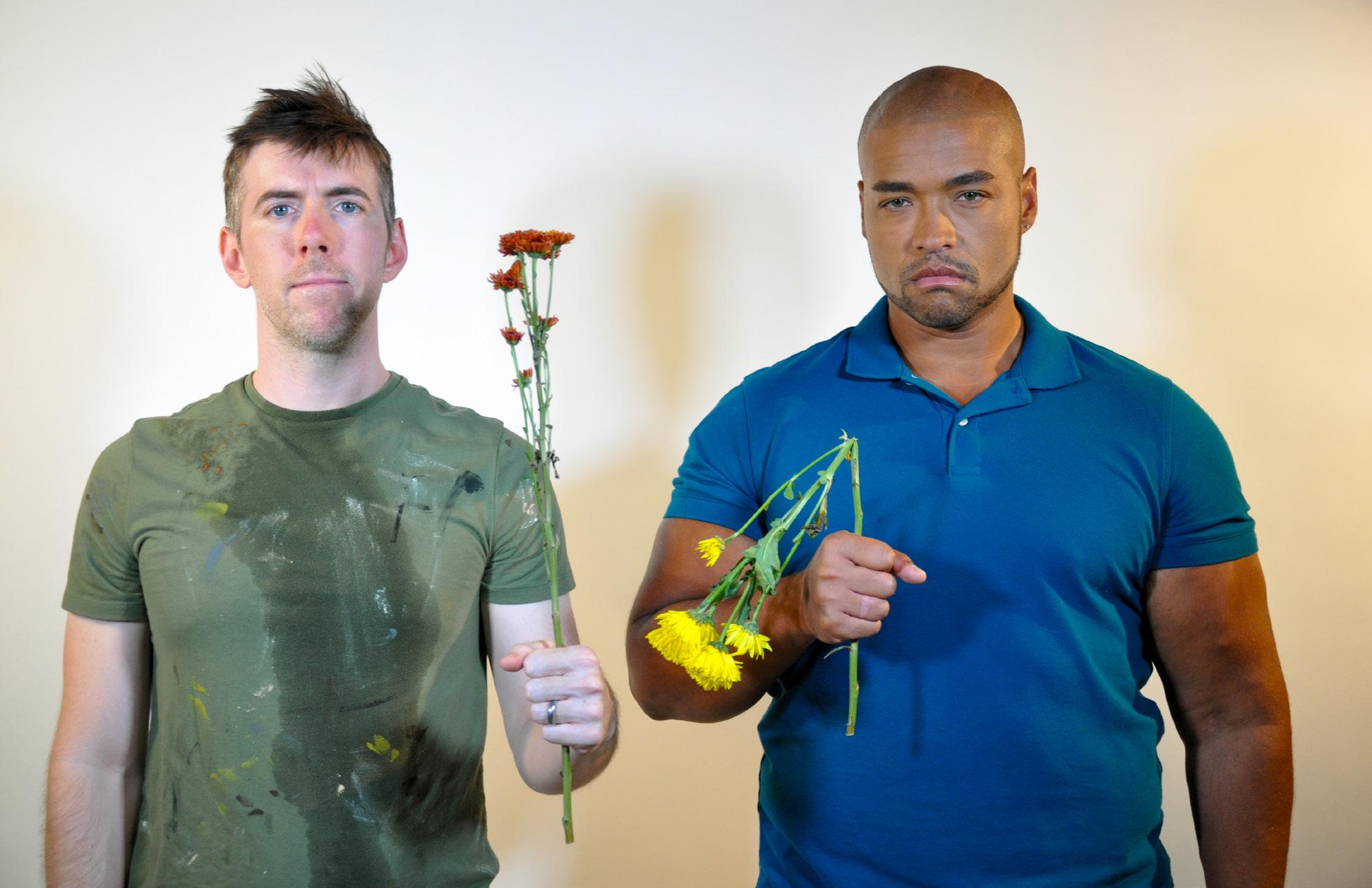
Is it always perfect bliss to live and work with your husband?
Absolutely not! We do a really great job of communicating with each other and finding common ground when there is conflict. In addition to that, we are both each other’s biggest supporter and we do what we can to help each other realize our dreams. We are, after all, a team. But perfection is boring and I’m a huge fan of things that are perfectly imperfect.
What can Marriage of Inconvenience teach us about love and marriage?
It’s important to be yourself in a relationship. Also, embrace love and laughter. We all need it in our lives!
Marriage of Inconvenience is streaming now on Dekkoo.com.
23 JAMIE BOOTH is a freelance writer based in Boulder, Colorado. He describes entertainment writing as a pleasant distraction that takes him to places unknown and fulfills his need for intellectual stimulus, emotional release, and a soothing of the breaks and bruises of the day. STREAMING
IT’S OPEN SEASON ON CAZDEN HUNTER
We catch up with the adult film star
By Larry Olsen
Cazden Hunter is a well-known name in the adult film industry. In just two years, he has established himself as one of the most in-demand young talents in the biz.
Born and raised in Los Angeles, where he currently resides, Cazden has go-go danced at Folsom Street Fair in San Francisco and Market Days in Chicago. He has also performed for some of the biggest studios, including Falcon Studios, Men.com and, perhaps most memorably, the fetish site KinkMen.


Did you really come out in the 10th grade?
I came out as bi in the sixth grade, but in 10th or 11th grade I came out as gay. I had been only fooling around with boys for a long time, and everyone knew.
And is it true that you always dreamed of being an adult film star?
Yes! I thought it was sexy and enticing, and I viewed it as art, too. My first porn crush was on Brent Corrigan. I wanted to top him so bad. At the time, I was too scared to bottom.
What came first: film, go-go-ing or escorting?
I started go-go dancing first. Then I got into film and it seemed to go hand in hand with escorting, so I started that not too long after.
How did the first film go?
It was a bit surreal and I was a little taken aback at first because it
Cazden’s willingness to be tied up and dominated has made him a favourite with fans. He’s also extremely versatile and always up for trying new things, including the latest porn craze, pup play. He says working in the adult industry has made him realize he’s kinkier than he thought.
We caught up with him in Las Vegas at the KinkMen studios to discuss his latest film work and his new podcast, Out of the Kennel: Kink, Fetish & Queer Life.
was with a female videographer. Luckily, she was very professional and made me feel comfortable. Still, it was awkward because my scene partner was straight and he seemed uncomfortable working with me.
What are the best and worst parts of the job?
Best parts are travelling and meeting new people. I also really like live performances. The worst parts are getting up really early to prep for bottoming and having to hold awkward angles during sex.
When did you first get into kink?
My first kink was public play when I was a teen because there was no place for us to fool around. Other than that, it was my second time going to Folsom when I discovered pup play.
What attracted you to pup play?
I was immediately intrigued by it. I already acted like a puppy
24 IN MAGAZINE MAY / JUNE 2023
SEX
Photo by Meaty Panda
with my partner at the time, I just didn’t know there was a thing for it. I really enjoy building a headspace in which I’m discovering new things. Also, rolling around with other pups is fun – and the treats! My favourite treats are Tamarindo candy and berries.
You are Cybersocket’s reigning pup of the year! What does that responsibility entail?
I’m not sure! No one told me. But I take it upon myself to be friendly, open, approachable, visible and encouraging. I often offer help and advice to people who are curious about the community.
KinkMen.com plans to film more pup play scenes. Do you intend to be a part of those productions?
I do, and I hope I get to explore and bring my pup experience to the screen. I want to be involved and show pup play in the many ways it can be: pup play by pups, for pups.
What scenes have you filmed for KinkMen?
I’ve done four scenes with them: all have involved toys and being bound in some sort of way, but each had something a little different. Two were as a human and two as a pup. My first one was with Cesar Xes, which involved tickle torture. I’m actually very ticklish! My second was with Dominic Pacifico and Arturo Santos, which had some cock and ball torture. My third was as a pup with Bobby Ryker where I tried electro for the first time and some piss play. My most recent scene was with Devin Franco and that had cropping, and it was the first time I experienced a jack-off machine.
How would you describe working with Dominic Pacifico as a director?
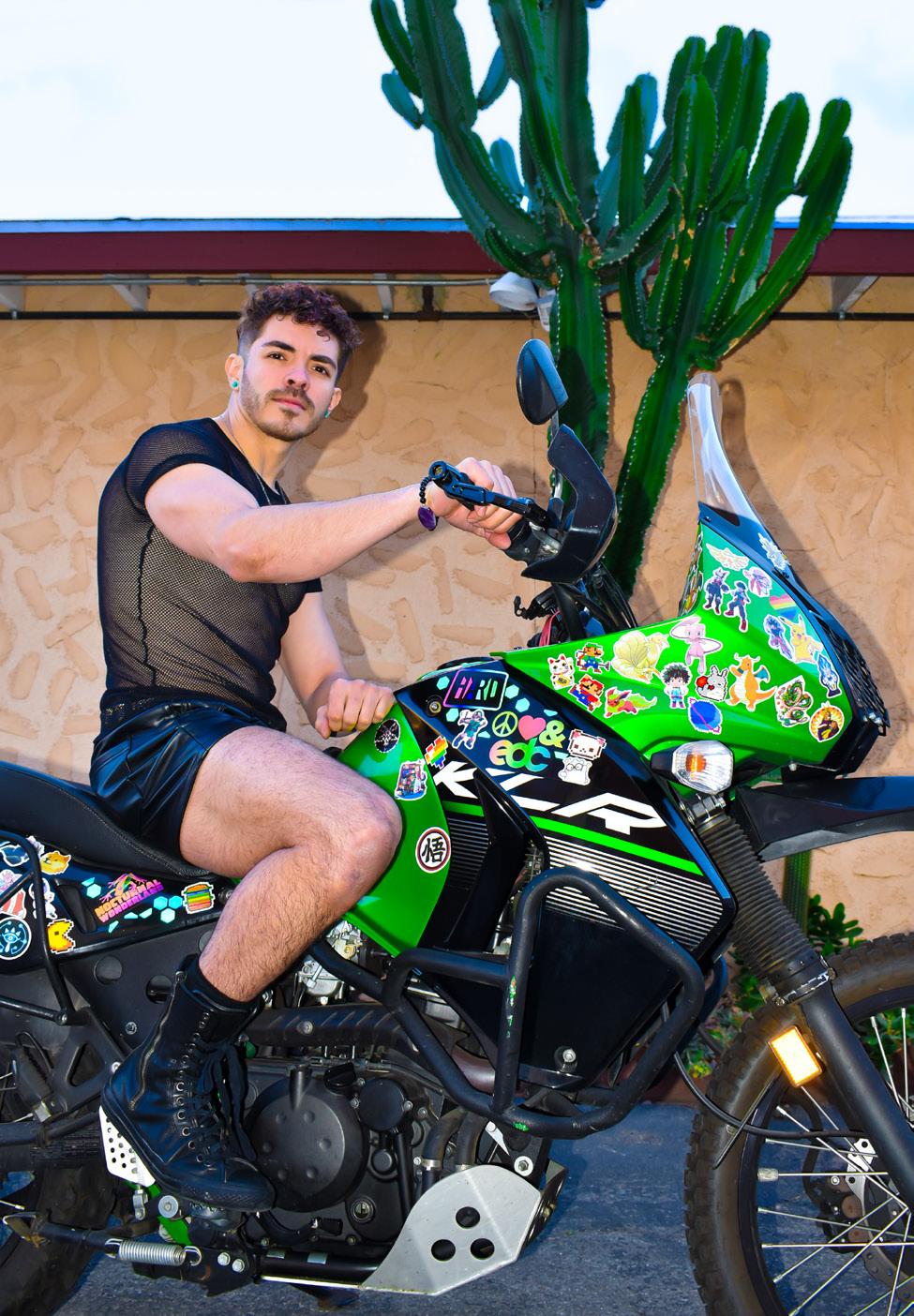
He knows what he wants. You can tell he has a vision for the scene.
Do you plan to follow his footsteps into directing adult films?
Directing is something that has crossed my mind, but I’m not sure yet.
You and your pup handler launched a podcast!
Yes, our podcast is called Out of the Kennel . It is about queer life, kink, fetish, nightlife and health. Meaty Panda co-hosts and we’ve had all sorts of guests. Dominic Pacifico did the show!
Is Brent Corrigan your dream guest?
He would be fun! I like having guests in the community that I don’t know much about so I can learn new things.
What is something fans would be surprised to learn about Cazden Hunter?
I can be really shy at times.
Do you have a secret talent?
I’m really good at drawing, cooking, aggressive inline, and video games.
What is your idea of perfect happiness?
My favourite thing to do in the world is snowboarding. I love it so much and I also love the mountains. The smell, the views… nothing brings me such peace. Snowboarding itself makes me
feel so free and the better I get at it, the freer I feel. To be in a place in my life where I can go from the city to the mountains any time I wanted would be my ideal happiness.
What is your greatest fear?
Living a life where I stop trying.
What is your most treasured possession?
My drawings. They may not be the greatest, but they’re a part of me, and some of them I put a lot of meaning into.
If you could change one thing about yourself, what would it be?
To not second-guess or doubt myself.
What is the trait you most deplore in others?
I think it would be selfishness and greed. It makes people do some of the most awful things.
When it is all said and done, how do you hope Cazden Hunter will be remembered?
As a genuine person, not defined by one thing, but who was kind, loving, understanding, and inspired others to do the same.
25 SEX
LARRY OLSEN defines himself as a teacher, reader, writer and dreamer. He lives in Palm Springs, Calif., with his partner of 22 years. In his spare time, he enjoys interviewing underground artists and exposing their unique talents to the light.
Cazden Hunter’s latest film takes place in a dark BDSM playroom with co-star Devin Franco. Watch it now at KinkMen.com.
Photo by Meaty Panda
IS AI FACIAL RECOGNITION
IS AI FACIAL RECOGNITION
TRANS-INCLUSIVE?
TRANS-INCLUSIVE?
Does AI, specifically facial recognition, fail to recognize transgender people, or misgender them? And, if so…what needs to be done to fix it?
 By Warren Urquhart
By Warren Urquhart
26 IN MAGAZINE MAY / JUNE 2023 ARTIFICIAL INTELLIGENCE
Photo by Markus Spiske on Unsplash
With every headline about AI being a grandiose proclamation about how utopia or dystopia is around the corner, it’s easy to forget how embedded AI is in our lives already.
If I make a typo, the autocorrect function that fixes the typo is AI. To log into the laptop I am typing this on, my computer unlocked by recognizing my face through its camera – that’s AI. For those of you with iPhones that have facial recognition – you use AI every time you look down to unlock your phone, which the average person does 58 times a day.
Despite its already large presence, AI (like most parts of our society) is not built for trans and non-binary folks. A 2019 study by Scheuerman, Paul and Brubaker of the University of Colorado Boulder looked at the accuracy of facial analysis (FA) tech, like facial detection and facial recognition, specifically in how it identified the genders of cis, trans and non-binary people. The results showed a large disparity in accuracy at identifying cis people versus identifying trans and non-binary folks.
The study looked at the technology from Amazon, Clarifai, IBM and Microsoft, and then aggregated all of them to determine their collective accuracy. The overall accuracy was the highest for women (at 98.3%), followed by men (97.6%), trans women (87.3%) and trans men (70.5%). Agender, genderqueer and nonbinary groups had a 0% accuracy rate as, at the time of the study, the relevant FA tech only had binary gender labels, and given that those groups are outside of the gender binary, it was impossible for any of the services “to return a correct classification.”
The possible explanation for this inaccuracy also leads us to the solution. The study surmises that it was likely “the training data used to train FA services [did] not include transgender individuals – at least those who [did] not perform gender in a cisnormative manner.” The reason the study presumes this is because gender labelling, like many AI programs, is a “black box” where we see the output, but don’t understand how the algorithm got to its conclusion. When it comes to transgender folk, the large discrepancy can likely be fixed by simply including more trans people in their datasets when training the FA model.
For non-binary people, the fix would likely need to be more ambitious. Not only would they have to be included in any training dataset, as with trans people, but facial AI technology would have to include the output or label of “non-binary,” “agender” or “genderqueer.” Yes – the study was published in 2019, and FA has likely grown quite a bit since then. But if trans people aren’t included in the models used to train FA AI, and the program isn’t designed to create an output label of “non-binary” – then the issue of FA misgendering non-cis people will stand.
From anecdotal experience, I presume that there have already been advances in this issue since the study. This mostly comes from the experience of seeing more and more forms and surveys include options for gender identity besides “man,” “woman” or “do not wish to disclose.” When governments and large organizations acknowledge and provide the options to identify beyond the gender binary (Canada was the first country to provide census data on trans and non-binary people), this helps set the standard
for tech companies needing to be more inclusive in how they work with gender.
Of course, the progress that has likely come since 2019 is not enough. In 2021, non-binary and trans scientists advocated for US governmental agencies to include gender-inclusive options. An app called Giggle, self-described as a social media app for “females,” uses FA technology to determine if a potential user is male or female. If female – they can join. If not, they can’t. While the app used to include trans women, the CEO of Giggle now openly admits that the app excludes trans women, through its FA technology from Kairos AI to exclude trans women.
The results of the Boulder study are very useful for those who want to design FA systems that include the trans community, and for LGBTQ people and allies to push for better FA systems. However, Giggle brings up a much larger point – that perhaps, without the right guardrails, FA technology that is better at correctly identifying non-cis people might actually have catastrophic effects. A side effect of FA systems that are better at recognizing trans and non-binary folks is that those who wish to use FA against those communities now have a more accurate weapon to do so. In its effort to exclude trans women, Giggle found its AI was excluding cis women as well – through FA that is better at detecting trans people, Giggle’s ability to accurately discriminate would grow.
Not to belittle the harm Giggle is causing the trans community – but the stakes are much higher than one transphobic social network. James Vincent of The Verge wrote an excellent article that details the case that many LGBTQ groups are making: ban automatic gender recognition technology entirely. The article details the scene in Chechnya, where LGBTQ people are being imprisoned by authorities that are not using AI. With FA that can accurately identify LGBTQ people, authoritarians would be able to imprison trans and non-binary folk with more ease. Another example is housing discrimination, a common issue for transgender people – and one that could get worse as some landlords push for facial recognition technology security systems. With the proliferation of anti-LGBTQ bills in the United States, is it really that much of a stretch to suggest that FA technology that accurately recognizes trans and non-binary people will do more harm than good? I’d argue it’s not a stretch – but on the other hand, abandoning the project of creating trans-inclusive AI or facial recognition technology will exclude those communities from the benefits those technologies can bring. For example, in medicine (where trans people already get the short stick), facial recognition technology has been shown to be apt at detecting rare genetic conditions. Trans folks deserve all the benefits that medicine can bring to cis folks.
Nonetheless, all the medical advancements in the world don’t justify (1) not developing a stronger anti-discrimination legal and technological framework that protects trans folk, and (2) not banning the use of FA technology where the risk of harm to trans, non-binary folk and other vulnerable communities far outweighs any benefits. Developing a strong protective framework will be difficult, but AI developers, technologists and policy-makers have a moral imperative to start working to protect and empower trans and non-binary people, through centring the voices of these vulnerable communities in their technical and political decisions.
WARREN URQUHART is a soon-to-be consumer protection lawyer finishing up the licensing process in Ontario (none of the opinions expressed represent the views of Warren’s employer). When he’s not writing or working, he’s drinking coffee or lifting weights (sometimes at the same time!).
27 ARTIFICIAL INTELLIGENCE
SHEARSGENIUS
Jake Shears opens up on the eros and ethos behind his groundbreaking album, Last Man Dancing
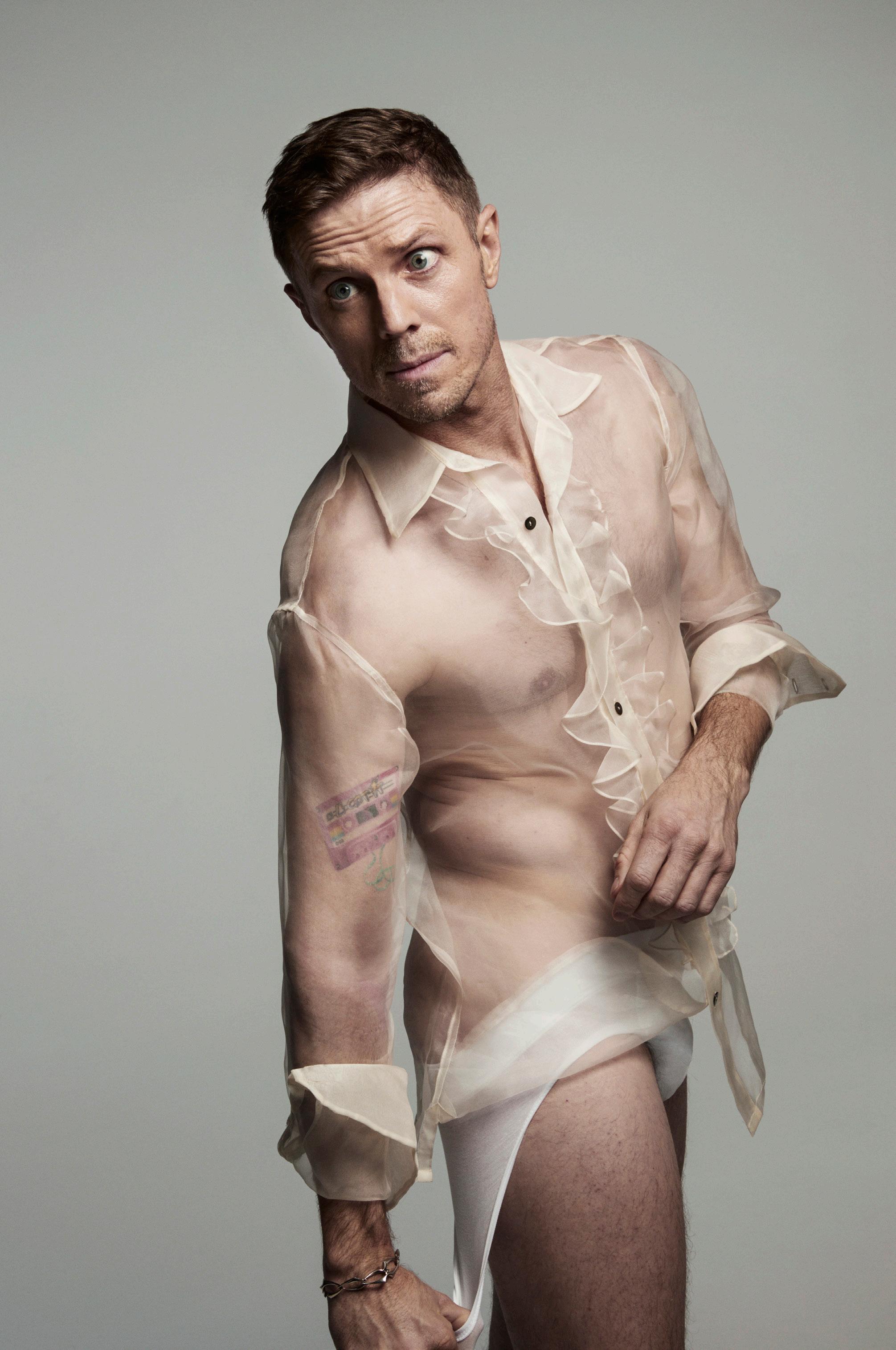 By Elio Iannacci
By Elio Iannacci
28 IN MAGAZINE MAY / JUNE 2023 COVER
Poho By Damon Baker
If ever there was an album born to be adapted for a biopic, it’s Jake Shears’ Last Man Dancing. Fuelled by the dramas, traumas and hot mammas pinched from five decades of queer nightlife, Shears’ 12 new songs present as epic movie scenes made to be meme-ed about. Each track has an intricate storyline of its own, mining the emotional depths of queer life and love in a way that reflects the astute collection of iconic names invited to collaborate with Shears. This includes a stellar VIP list ranging from Big Freedia and Jane Fonda to Kylie Minogue and Iggy Pop.
Although Last Man Standing counts as a sophomore album for the former front man of the Grammy-nominated pop group known as the Scissor Sisters, it is wholeheartedly giving major debut energy. It simply needs to be reiterated: if there’s a modicum of justice in the world, the album should sweep the next Grammys, as it delivers in ways that Shears’ past solo efforts merely point to. The project shines with glorious, danceable verses and unforgettable choruses, and blends house, trance, disco, funk, rock and folk while serving an off-the-cuff audaciousness that would make both Lil Nas X and Charo proud. As would the bold, theatrical songwriting on it.
Your memoir of 2018, Boys Keep Swinging, looks back at early 2000s nightlife in New York City, a time where you wrote: ‘People feared touching each other.’ After living through another pandemic, is your new album an exercise in PTSD, nostalgia or a manifestation of hope for the future of dance music?
All of the above. The record has two very distinct parts. There’s the pop songs on the first side, and then on the second side of the record, where I’ve never really gone. It’s one big chunk of dance music that flows in this nostalgic way – almost like you’re spending a whole night on the dance floor. The Scissor Sisters hinted at that with our album Night Work, but I think the second half of [Last Man Dancing] takes it further. ‘Last Man Dancing’ – the song – looks forward because it showcases how much my song craftsmanship has developed and where it is going.
That second part of the album has fewer vocals from you on it too – which is so unlike your debut disc. Why?
At some points I just disappear off the record entirely. You’ve got Amber Martin doing the lead [on ‘Devil Came Down The Dance Floor’], then Big Freedia comes on strong [on ‘Doses’]. There are whole parts of the album where I just go away and let the music take over. I love producing music but I don’t necessarily feel the need or desire to hear myself sing on everything. I’m more interested in the musical creation and what that journey sounds like and brings you to…rather than keeping me in the centre of everything.
‘Voices’ – your duet with Kylie Minogue – is one of the strongest examples of queer-diva collaboration I’ve heard in a long time. There are so many iconic works that queer artists and divas have made together, from Liza Minelli and the Pet Shop Boys to Madonna and Junior Vasquez to Lady Gaga and Nicola Formichetti. How do you think you and Kylie fit into this legacy?
Kylie, Kate Bush and Dolly Parton…they all have this thing that they can do with their voice – a softness and lilt that appeals to me so much – nobody else can do it. Kylie, who I think is one of the greatest voices we’ve got, is also somebody I love very much, and you can get that from our work together: it pours into the music.
Fuelled by Shears’ past work – starring in Broadway’s Kinky Boots, his side hustle as lyricist on the bio-adaptation of Tammy Faye Bakker’s life and his stint as co-creator of Armistead Maupin’s Tales Of The City musical – his new album’s lyrics go beyond just having a kiki. Instead, Shears’ songs echo moments on the dance floor that lead to thirsty sexual connections and the filthy/ gorgeous late-night hookups that follow. Shears’ orgasmic lyrics on the track “Voices” spell it out thoroughly – Last Man Dancing is constantly “calling you to action.”
Yet beyond the lusty wordsmithing, Shears’ vocals on the disc –solo, background and in duet mode – are a fierce force to contend with. Notes are delivered in such a way that Shears effortlessly tributes and amalgamates the sonic stylings of the superfecta of queer voices that came before him – precursors such as Sylvester, George Michael, Elton John and David Bowie.
In the midst of rolling out his new crop of songs and planning his first major tour in years, Shears sat down with IN Magazine to discuss how his life, art and queerness overlap and intersect.
The way I hear her flavour of sound and the texture of her voice comes from a big connection between queer men, gay men and divas and female singers.
Have you always been aware of this connection?
Yes. In the past, we’ve always funnelled our hopes, dreams and fears through divas. They are the mouthpieces of our expression – all the way back to Judy Garland. That’s what so many queer people end up doing: work with a lot of divas who are these intensely powerful women with big voices. It’s something that’s inherent in gay and queer culture: they see themselves in us, we see ourselves in them. Also: gay men are able to hear their desires expressed freely with divas in a way that they were never able to express themselves. And I think that is the tie, that is this relationship – and straight guys don’t have that, because they’ve been walking in the world without those insecurities, without fears, without that story.
A Scissor Sister’s song called ‘The Other Side’ includes a voice clip of Judy Garland saying ‘I have a right to be in love. I have a right to be loved. There will be over the rainbow for me.’ Looking back at that track, why was it important to end the song with her?
That’s the origin of what we’re discussing here. Judy was someone that gay men identified with. She had this gorgeous voice, and her dramas and problems became our problems and dramas. Gay men were obsessed with her and in some ways, she ended up becoming this Jesus Christ figure to many in the community. She died right before Stonewall and I think there’s definitely a confluence there. That devastation had to have fuelled the anger that helped make Stonewall happen. I think that’s where that connection and that love, that bond, started to build. Judy Garland is the dawn of that legacy you’re talking about.
Your new track, ‘Radio Eyes,’ features Jane Fonda. What does she represent in the song?
Believe it or not, a warning sign. I was working with her on this short called Future of The Flesh.… It is this over-the-top film with
29 COVER
a sci-fi quality directed by Luke Gilford for Prada. The movie is really creepy and I scored it. Jane graciously worked with me on it one afternoon and recorded dialogue for it. When I was making this record, I used her raw take for the song and sent it to her. She was just like, ‘Have at it. Go for it.’ It’s a theatrical story about aliens coming and taking us over – a full fantasy. You realize halfway through the song that Jane’s line – ‘If you receive this message should anyone return, run and tell the others the situation’s turned’ – is really bad news, as she’s saying the humans are being defeated. Sometimes my songs are scripts: I’ll create a character and story around that role. With that song, it goes into this really intense breakdown, and shoots out into a triumphant instrumental.
Were there any soundtracks you were fuelled by?
I was thinking about the end of David Lynch’s Dune. I wanted to capture that feeling of when the Fremen tribe is controlling the sandworms and riding them through the dessert. I was also thinking of the character of Falkor flying in The NeverEnding Story
With all of its right-wing church allusions in the lyrics, your song ‘Devil Came Down’ sounds like a critique of Don’t Say Gay and anti-trans and anti-drag legislation. Did activism come into play while making this record?
I don’t make anything as a protest song, I try not to infuse any lessons or messages in the music I write. I find when you attempt such things, you usually end up with something really bad. Rick Rubin just put out this amazing book on creativity, and writes about how you don’t know the cultural repercussions of whatever it is you make. He thinks – and I agree – that the context your creation lives in and comes out in actually decides whether something ends up being a protest song for you. Any time you try to be didactic or moralize something in music, I find that it can really turn out to be horrible.
Then you have someone like Sandra Bernhard, another friend of yours, who believes that just being yourself is a stance and a protest. Is that something you agree with?
Yes. Being true to yourself and making art is inherently a political act, but if you think about it too much, I think it can spoil the fun!
‘Mess of Me,’ ‘Last Man Dancing’ and ‘I Used To Be In Love’ all sound like they were written pre-Grindr, and capture this idea of picking up a lover on the dance floor. Was nightlife in the early 2000s part of your own sex education?
Oh my God, yes! I think about this so much. Nightlife is an amazing way to learn socialization, and to learn how to be able to look out for yourself and fall in and out of love. You have got to figure out how to talk to people off-screen. I’m in London now…it’s a great town, but it blows me away how there are few casual, queer hangs and bars. I feel like the culture has really moved into big, ticketed events. There’s no spontaneity in it: you’ve got to plan ahead, stand in line, go through security, be in these giant rooms where there’s very little connection happening. There’s something to be said for the smaller dance floors and intimate clubs.
So if clubs were like colleges or universities, which ones had the best classes?
At the time I hated it but I look back now and realize how special The Roxy in New York City was.… DJ Peter Rauhofer was a genius.
I learned a lot from The Cock in New York and that was a more intimate space. I lived right above it, so having that access and being able to pop in and hang out and meet people was amazing. One of the main reasons why I go out or go clubbing is to hear music I haven’t heard and find stuff that turns me on. I would find that at The Cock when Sammy Joe was DJing there. He became one of my best friends, and we’ve got a radio show on Sirius XM every Friday now. I found amazing weird, classic rock stuff at The Cock, songs that would really inspire me like ‘Walk the Night’ by Scat Brothers.
Over in Williamsburg, it was all the new electro stuff that was coming out and ’80s vintage electronic pop that I never knew… Wham! records I knew nothing about, Human League records I haven’t heard yet. I feel like that education still hasn’t stopped.
It was strange to read in your memoirs that the Scissor Sisters were once considered electroclash. Was the backlash for the genre something you felt was detrimental to the Scissor Sisters? It was something we had to shake off but without electroclash, I don’t think we would’ve existed. I just read a biography of Sylvester called The Fabulous Sylvester, which I highly recommend. He started out with The Cockettes, which was this ramshackle, crazy, honky-tonk, piano hippie group, but Sylvester was doing something completely different and they offered a stage for him to later reconsider. Electroclash was like our stage.
You were outed by a classmate when you were caught reading a sequel to V.C. Andrew’s to Flowers in The Attic – a book called If There Be Thorns. How have books shaped your lyricism? Reading is really important to me, as is watching film and taking in art. The more you feed yourself, and the more you suck it up, the more your brain expands and allows for creativity. Sometimes you just see something, read something or hear something new, that makes you want to write.
When was the last time that happened?
Will Gregory, who is the main producer from Goldfrapp and Portishead, just did a live score for this crazy British collage film called Arcadia, about Britain and its relationship with agriculture
30 IN MAGAZINE MAY / JUNE 2023
COVER
“THEMOREYOUFEED YOURSELF,ANDTHEMORE YOUSUCKITUP,THEMORE YOURBRAINEXPANDSAND ALLOWSFORCREATIVITY.”
and paganism. That gave me a rush. It felt similar to when I was 12 and saw The Rocky Horror Picture Show for the first time. I knew there was something magical in it, something that was going to change my life. I just knew it.
Was Rocky Horror a forecasting of a future for you?
Definitely. I was starving for it, and it was forbidden to me to see it. I look back when I was 15 and couldn’t date any queer kids my age for a long time, so it shaped me. I’m so glad that I’m not growing up in this moment, right now.
I wonder if Scissor Sisters songs like ‘The Year of Living Dangerously,’ ‘Sex and Violence’ and ‘Self-Control’ could be made without adversity?
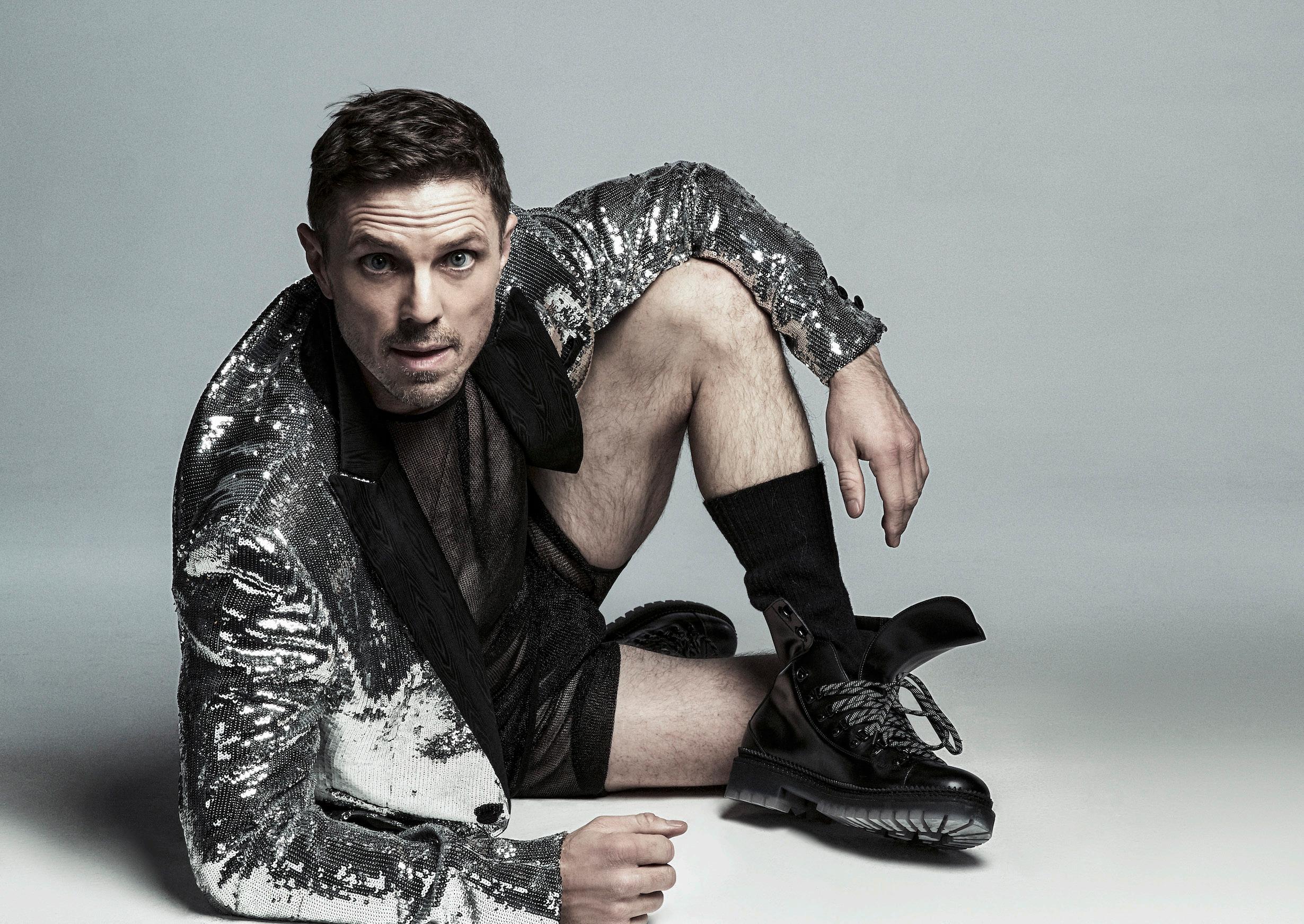
I love using those dark forces and using darkness as a colour in my work. ‘Do The Television’ is a very dark song – even though it has this uplifting chorus, it’s really creepy and very unsettling.
In a previous interview, you mentioned that the song was about the loss of meaning and forgotten histories. Tell me about the history that you think the next generation of queers should not forget?
I hope queer people growing up have the curiosity to figure out where they come from. I’m fortunate to have been born in 1978 – I came of age during AIDS before the cocktail, [and I] experienced what that felt like, to move around in the world as a gay guy, with
death permeating your existence. I was told as a 16-year-old coming out to my parents that being gay was a death sentence. I’ve been out for 30 years now and I feel like I lived through an important portion of queer history.
In your memoir, you wrote about how you emailed David Bowie and told him that you didn’t want to cross paths with him after he saw you in concert. Did you ever change your mind or see him again?
No. It was just too overwhelming for me at the time. At my desk, I have an altar to him that I light three times a week. When he saw me sing, I did not feel worthy, I felt like a fraud. Just getting any attention from him was too much. He was a god to me and how I first fantasized about becoming a performer. I think my spiritual relationship with him is stronger than ever.
One of the most interesting periods of Bowie’s life was when he met and collaborated with Iggy Pop. You end your album with clips from an old Iggy Pop interview, taken from the CBC in 1977. Why?
Iggy was out there on the show, giving this spiel on how he feels about music. We had to get it licensed from the CBC, but it was worth it. It’s such a beautiful moment and it makes for such a great thesis for this record. He summed up the art of performance and defined the process of making music to me in a way which made me have a deeper understanding of my own album.
31 ELIO IANNACCI is an award-winning arts reporter and graduate student at York University whose research interests include ethnomusicology and gender studies. He has contributed to more than 80 publications worldwide, profiling icons such as Barbra Streisand, Lady Gaga, Aretha Franklin and Beyoncé. His academic work is supported in part by funding from the Social Sciences and Humanities Research Council. COVER
INSIDE OUT GIVES BACK
Money talks at Inside Out.… After all, it’s more than just the movies
By Ingrid Randoja
When the Inside Out Film Festival debuted in 1991, Toronto’s queer community embraced it like a newly found lover.
For the past 32 years, 2SLGBTQ+ audiences have flocked to the festival to see themselves onscreen, and while queer representation has increased in both mainstream films and television over the years, showcasing diverse, queer-made films in front of queer audiences instills a sense of community pride and belonging that can’t be replicated in any other setting.
This year’s festival takes place May 25–June 4 in a hybrid format with both in-person and online screenings (available to Ontario residents only). The lineup includes anticipated and discovery feature films, documentaries, short film programs, gala screenings and, of course, an array of parties taking place throughout the 11-day event.
Inside Out offers more than just film screenings: it also works to help get films made via its Film Finance Forum. The forum – the first and only 2SLGBTQ+ finance forum of its kind in the world – gives 2SLGBTQ+-identified producers, writers and directors a platform to pitch their market-ready features, documentaries and Canadian series projects directly to top international industry executives and decision-makers.
“Our seventh edition of the Queer Finance Forum expands to three days this festival to include a day of free professional development opportunities for emerging queer filmmakers,” says Inside Out co-head and artistic director Andrew Murphy.


“This, paired with our perennial two-day B2B forum featuring eight to 10 market-ready feature projects at the development stage curated and matched with executive pitch meetings, puts Inside Out front and centre in advocating for the increased presence and value of our queer stories onscreen in the world marketplace.”
To date, nearly 40 per cent of the projects that have participated in the forum since 2017 have been financed, produced and released, or will be going into production this year.
“The Inside Out Finance Forum is a wonderful experience where not only do you connect with financiers and sales agents, but also other queer filmmakers from all over the world, and you get to experience a sense of community – filmmaking can be lonely work before you’re on set,” they say.
“Being able to troubleshoot with other queer directors/producers allows you to see you’re often dealing with the same issues. We’re happy to say that we are going into production in 2023!”
One of the Forum’s local success stories is the feature Something You Said Last Night. Directed by Toronto-based filmmaker Luis De Filippis, the dramedy follows a trans woman who goes on a beach holiday with her supportive family while dealing with a personal crisis.
Something You Said Last Night made a splash at various film festivals around the world, winning prizes at the San Sebastián and Rotterdam festivals as well as winning the TIFF Change Maker Award; it will be shown at this year’s edition of Inside Out.
32 IN MAGAZINE MAY / JUNE 2023
Filmmaking team James Watson and Mikko Makela participated in last year’s forum, bringing their UK/Finnish film project Sebastian to the table.
FILM
INGRID RANDOJA is a freelance arts writer. She is the former film editor of NOW Magazine and the former deputy editor of Cineplex Magazine.
THEFIVEDEVILS
THEFIVEDEVILS
GIVES QUEER ROMANCE AND FAMILY SECRETS A NEW PERSPECTIVE
GIVES QUEER ROMANCE AND FAMILY SECRETS A NEW PERSPECTIVE
GIVES QUEER ROMANCE AND FAMILY SECRETS A NEW PERSPECTIVE
The new French film from acclaimed director Léa Mysius takes time travel and family drama to new heights this year
By Matthew Creith
French director Léa Mysius’ second feature directorial effort, The Five Devils, premiered at last year’s Cannes Film Festival in the Queer Palm category, receiving a remarkable five-minute standing ovation from the audience. Built as a fantasy thriller seen through the eyes of a young girl, the film uses magical realism as a device to get across its points of real-world issues like racism, homophobia and sexism. Written by Mysius and Paul Guilhaume, who was also the movie’s cinematographer, The Five Devils is a strikingly visual drama about one family’s shared history.
The movie takes place in a quaint village at the foot of the Alps, where eight-year-old Vicky (Sally Dramé) lives with her mother Joanne (Blue Is the Warmest Colour actor Adèle Exarchopoulos), a former champion gymnast, and her firefighter father Jimmy (Moustapha Mbengue), who is originally from Senegal. Vicky is biracial, and other girls her age often tease her for that. They specifically make fun of her hair, referring to her in conversation as “Toilet Brush.” But Vicky is a confident child with an uncanny ability to take scents and collect them in jars so she can connect memories to them. Her sense of smell is otherworldly, and her mother knows it, which helps bring them closer together.
The family’s simple life is disrupted when Jimmy’s sister, Julia (Swala Emati), appears out of nowhere. Julia has a devastating past that the small town they all reside in hasn’t forgotten about, which comes into focus towards the end of the movie. It’s also clear that there’s friction between Joanne and Julia because of something that occurred in the past that isn’t fully realized at first. Due to Vicky’s supernatural insight into fragrances, she senses something in Julia’s
past that needs exploring, which propels Vicky to time-travel. For some reason, Julia is the only one who can see Vicky when the young girl travels to the past, which in turn reflects an observation of crucial moments in her family’s narrative.
The time-travel element is the film’s main plot tactic. While it’s an interesting aspect from the start, it proves divisive as the film progresses. Unlike movies such as Back to the Future, Vicky’s meddling in the past doesn’t seem to have dramatic effects in the present, especially when Julia is involved. Vicky is merely an observer for much of the movie rather than someone who can make necessary changes to her family’s well-being.
Through Vicky’s experiences, the audience is exposed to the discriminatory attitudes and actions of some of the town’s residents. The Five Devils doesn’t shy away from these issues and is respectful in a way that doesn’t feel overly preachy. The supernatural element of the film adds a bewitching coating to the premise. Vicky’s ability to time-travel and witness crucial moments in her family’s history is a unique concept that provides a fresh perspective on the genre.
The Five Devils lost the Queer Palm award at the 2022 Cannes Film Festival to the Pakistani drama Joyland, which went on to be shortlisted for the Academy Award for Best International Feature Film. But after its initial presentation on the French Riviera, The Five Devils continued its film festival run by appearing at the Austin, Texas-based Fantastic Fest, where it took home the prize for Best Picture in the Next Wave Competition. Since then, the movie has racked up some other high-profile nominations and awards,

33
THEFIVEDEVILS
FILM
including a well-deserved nomination for Best Visual Effects at France’s César Awards and a win of the Best Director award for Léa Mysius at the 2023 Dublin International Film Festival.
The film has since been acquired by curated streaming service and distributor MUBI, which has given the flick a tagline that reads, “A spellbinding supernatural mystery forged from family secrets and queer romance.” A theatrical release will take shape in North America, parts of Europe, and Latin America. The Five Devils will also be available to stream on MUB later this year.

The cast of The Five Devils is impressive in every way imaginable. The film features some captivating performances, especially from Sally Dramé as Vicky, who has an intriguing presence and wisdom beyond her years. This is apparently Dramé’s first role in a movie, which is astounding given that she delivers some of the most poignant scenes in the film at such a young age. Even though she is young, it appears that Dramé might have a stellar acting career ahead of her if how she approached this role is any indication.
Adèle Exarchopoulos’ Joanne strikes a dramatic chord in a film dripping with symbolism and intrigue. She takes risks here as a performer, as does Swala Emati as Julia, and both characters prove sexual fluidity to be a mainstay of this fantasy drama that further explores queer identity in a very fantastical way.
Exarchopoulos, now 29 years old, first came to viewers’ attention in 2013 with a brilliant performance in Blue is the Warmest Colour That film was also shown at the Cannes Film Festival, where she was given the Palme d’Or. Not even 20 years old at the time, Exarchopoulos became the youngest person ever to win the award. From there, her career has skyrocketed to international recognition, to the point that she will next be featured alongside British actor Ben Whishaw in Ira Sachs’ newest film, Passages. Passages had its world premiere at this year’s Sundance Film Festival and will be released to global audiences this summer.
After 2017’s Ava, this is director Léa Mysius’ second feature film, although you’d think she was a veteran filmmaker given how stylish and deep The Five Devils can be at times. The movie straddles the
line of several different genres and opportunities at once, blending together ideas from fantasy, supernatural, queer drama, thriller and familial tension storylines that have made their way into global filmmaking for generations.

Releasing to wider audiences this spring, The Five Devils is a visually stunning and captivating piece for the modern age, filled to the brim with a marvelous soundtrack that elevates a typical family drama to astounding heights. Léa Mysius creates a dark and mysterious atmosphere that permeates every scene. The use of colour and light is exceptionally vivid, with bold and saturated hues used to create a dreamlike quality to the visuals, thanks in large part to the cinematography by Paul Guilhaume.

34 IN MAGAZINE MAY / JUNE 2023 FILM
Entertainment
in
With
Watch The Five Devils, the wildly imaginative breakout from writer-director Léa Mysius, streaming exclusively on MUBI from May 12. A MUBI release. Get 30 days free at mubi.com/INMagazine.
MATTHEW CREITH is a freelance journalist based in Austin, Texas. He is a member of GALECA: The Society of LGBTQ
Critics, and participates
the association’s Dorian Awards. You may also know him for his work on Matinee
Matt, Screen Rant and Giant Freakin Robot. You can find him on Twitter: @matthew_creith or Instagram: matineewithmatt.
CELEBRATE
WITH MEIGHEN FORUM THEMED WEEKS
PRIDE WEEK: JUNE 5 TO JUNE 11
THE STRATFORD FESTIVAL CELEBRATES 2SLBTQ+ HISTORY

SATURDAY, JUNE 10
SERVING PRIDE: A DINNER AND CELEBRATION
QUEER HISTORY IN CANADA
JUNE 15 — JUNE 17
AGIT-POP! STARRING PEARLE HARBOUR
JULY 3 — JULY 9
MEIGHEN FORUM’S NEWEST CURATED EVENT: THEMED WEEKS
AUGUST 7 — AUGUST 13
2023 SEASON DEEP DIVE
JULY 17 — JULY 23
CBC IDEAS WEEK: THE SHOCK OF THE NEW –THE TWENTIETH CENTURY
GLOBAL THEATRE WEEK
AUGUST 21 — AUGUST 27
READERS AND WRITERS WEEK
SEPTEMBER 11 — SEPTEMBER 17
SCHOLARS AND EXPERTS WEEK
SPEAKER EVENTS, LIVE PERFORMANCES AND DELECTABLE DINNERS— JOIN IN THE EXPERIENCE!
EXPLORE MORE: STRATFORDFESTIVAL.CA/FORUM
THE MEIGHEN FORUM IS GENEROUSLY SUPPORTED THROUGH AN ENDOWED GIFT FROM KELLY & MICHAEL MEIGHEN AND THE T.R. MEIGHEN FAMILY FOUNDATION
+ MORE
DANIEL BARTHOLOMEW-POYSER IS BREAKING DOWN BARRIERS… AND FEELING THORGEOUS!
We talk to the TSO’s Barrett Principal Education Conductor and Community Ambassador about presenting music in new and exciting ways, including his upcoming performance with Drag Race’s Thorgy Thor
Canadian orchestral conductor Daniel Bartholomew-Poyser is looking forward to a particularly meaningful Pride this summer. As part of Toronto’s 2023 Pride festivities, the Toronto Symphony Orchestra (TSO) will present Thorgy Thor and the Thorchestra at Roy Thomson Hall on Sunday, June 11. It’s a major cultural event, and something that the Calgary-born conductor personally created with Drag Race’s legendary “Queen of Classical Music,” Thorgy Thor.

Thorgy, of course, is set to bring her outrageous fashion sense, razorsharp wit, and violin to Toronto’s stage in the thrilling theatrical show. But it goes much deeper than song, dance and hilarious shenanigans. The can’t-miss symphonic spectacular is part of Bartholomew-Poyser’s mission to break down institutional walls and create live orchestral shows that are for everyone.
We sat down with Bartholomew-Poyser – who is also the star of the acclaimed CBC documentary Disrupter Conductor – to talk about his life and work, as well as creating the upcoming show that aims to bring together multiple generations across the rainbow.
Let’s kick things off and talk about Thorgy Thor and the Thorchestra. What should the audience expect?
You should expect a lot of surprises, first of all. It’s really not a traditional show! It mixes the best of Brooklyn drag with the best the TSO has to offer. Fans of Thorgy will leave the show feeling that they really got to see a lot of Thorgy, both being a renowned drag queen and a professional classical musician.
Is it true that it is the first orchestral drag queen show in Canada?
To my knowledge it was! There have since been others – notably with Tynomi Banks – but it is fair to say it was the first of its kind in Canada!
When did you first meet Thorgy Thor?
I met Thorgy a few years before the pandemic. I first met her in New York when I went to plan the show with her. I was a bit starstruck. It turned out that my favourite coffee shop in Greenpoint was not far from where she lived, so we met there. I remember being really impressed by the amount of imagination and the level of detail she worked with. It was a great first meet.
36 IN MAGAZINE MAY / JUNE 2023
CLASSICAL
Daniel Bartholomew-Poyser conducts the TSO
What was the process like putting the production together and working with Thorgy?

It was quite a lot of fun, and definitely a whirlwind! Thorgy has tons of ideas, so it was mostly a matter of picking the ones we thought would work best. On the orchestral side, I had a pretty clear picture of where things could go and what could be added to broaden the show. Thorgy is an orchestral musician, so this made it super easy. And did I mention fun?
Tell us about your role with and connection to the TSO. I’m the TSO’s Barrett Principal Education Conductor and Community Ambassador. I’m a lead on the team that curates the education and community engagement aspects of our work in Toronto’s music scene. It’s basically about making thoughtful musical connections between the TSO and the people in our community!
Your performance is happening during Toronto’s Pride Month. What does “Pride” mean to you?
“Pride” for me means “No Fear, No Shame.” It means we celebrate and make unity in the community. I say “make,” because unity is not a given, and is something we have to work on, having the courage to have difficult conversations that lead to more meaningful relationships. It takes effort and maintenance. Pride is both a celebration and a result of that work. I love that there is a specific time for us to be together.
What was your coming out like for you? Coming out was pretty difficult and took a long time. I think things are slowly getting better for people who are figuring things out.
I know that bringing live orchestral music to audiences that traditionally might not have access to it is pretty important to you. How are some of the other ways you are doing this? It’s not just about bringing music to new communities, but bringing the music in new ways. I’ve experimented a lot with audience interaction, mini-documentaries and pre-concert prep, as ways to
bring what’s happening on stage more powerfully to the audience members. But to answer your question, it’s been a lot of fun working with music of the 2SLGBTQ+ community as well as music of the Caribbean diaspora.
What is your advice to people who are looking to you as a role model? Get to work.
Who do you consider a role model?
John Barbirolli. He was both an exacting conductor and a consummate human being.
What do you want people to know about you that they might not already know?
I have my pilot’s licence and am a huge aviation nerd.
Last question. What’s next for you?
In the coming weeks and months, I’ll be developing more programs for the TSO and the GTA, and I’m looking forward to seeing what sort of creative stuff I’ll come up with, haha! I have a lot of travel and conducting in the US this summer, which will be extraordinary. My Carnegie Hall debut is in a month [May 22, 2023], and this summer I debut with the Baltimore Symphony, and will perform with the LA Phil at the Hollywood Bowl doing an all Tchaikovsky program. It’s really exciting. Then, after some time off, I’ll be ready to go for the fall!
COME CELEBRATE PRIDE WITH THE TSO!
Thorgy Thor and the Thorchestra comes to Roy Thomson Hall in Toronto on Sunday, June 11, 2023. For more information or for tickets, visit www.tso.ca/pride. Make sure you’re looking great and feeling Thorgeous!
37 CLASSICAL
Daniel Bartholomew-Poyser and Thorgy Thor
PUMA’S ‘FOREVER. CLASSIC.’ CAMPAIGN GETS A LITTLE LOVE FROM YOUNG HOLLYWOOD
Earlier this year PUMA unveiled its highly anticipated FOREVER. CLASSIC. campaign, featuring a mix of some of young Hollywood’s biggest rising stars. Actors Angus Cloud of Euphoria , Caleb McLaughlin of Stranger Things and Iris Apatow of The Bubble, and fashion’s new it girl Zaya Wade are all front and centre in the nostalgia-inspired campaign, which aims to celebrate some of PUMA’s legendary products. A pretty strategic way of introducing the younger generation to some of the brand’s iconic silhouettes, including the PUMA Suede, Clyde, Cali and Mayze.

There’s no doubt about it…the brand has some iconic roots. For more than 75 years PUMA has created sneakers, apparel and accessories that have helped to change the landscape of the sports footwear industry and inspired streetwear culture, especially in the ’90s, when the brand took the hip-hop culture by storm.
In the FOREVER. CLASSIC. campaign, the Gen-Z ambassadors pay homage to the sportswear label’s timeless and iconic shoes and apparel, from suede sneakers to trendier takes on classic looks, like pairs with platform soles. The debut campaign was shot by Kendall Bessent, an Atlanta-born photographer and 2022 Forbes 30 Under 30 Art & Style select, who showcases a new wave of creatives sporting the most timeless PUMA styles.
PUMA’s FOREVER.CLASSIC. products are designed to be timeless, and they’re ready to become the icons of tomorrow.
To shop the latest PUMA classic styles, please visit https://ca.puma.com/ca/en/puma/shop-all-classics.
38 IN MAGAZINE MAY / JUNE 2023
STYLE
Actors Angus Cloud, Caleb McLaughlin and Iris Apatow, and model Zaya Wade, are stepping into summer in style, thanks to PUMA
“To be a part of the FOREVER. CLASSIC. campaign highlighting PUMA’s most iconic and legendary products is surreal, you feel me? It’s so dope to be part of this next generation honouring the classics I remember from when I was growing up in Oakland.” – Angus Cloud
“The PUMA FOREVER. CLASSIC. campaign celebrates creatives pushing fashion and culture forward, which is why I’m grateful to be a part of such an inspiring group of people.” – Caleb McLaughlin

“PUMA is an iconic brand with 75 years of impactful moments and relationships in fashion, sports and music history. To be a part of a campaign highlighting the next generation of history makers is inspiring and so special to me.” – Iris Apatow

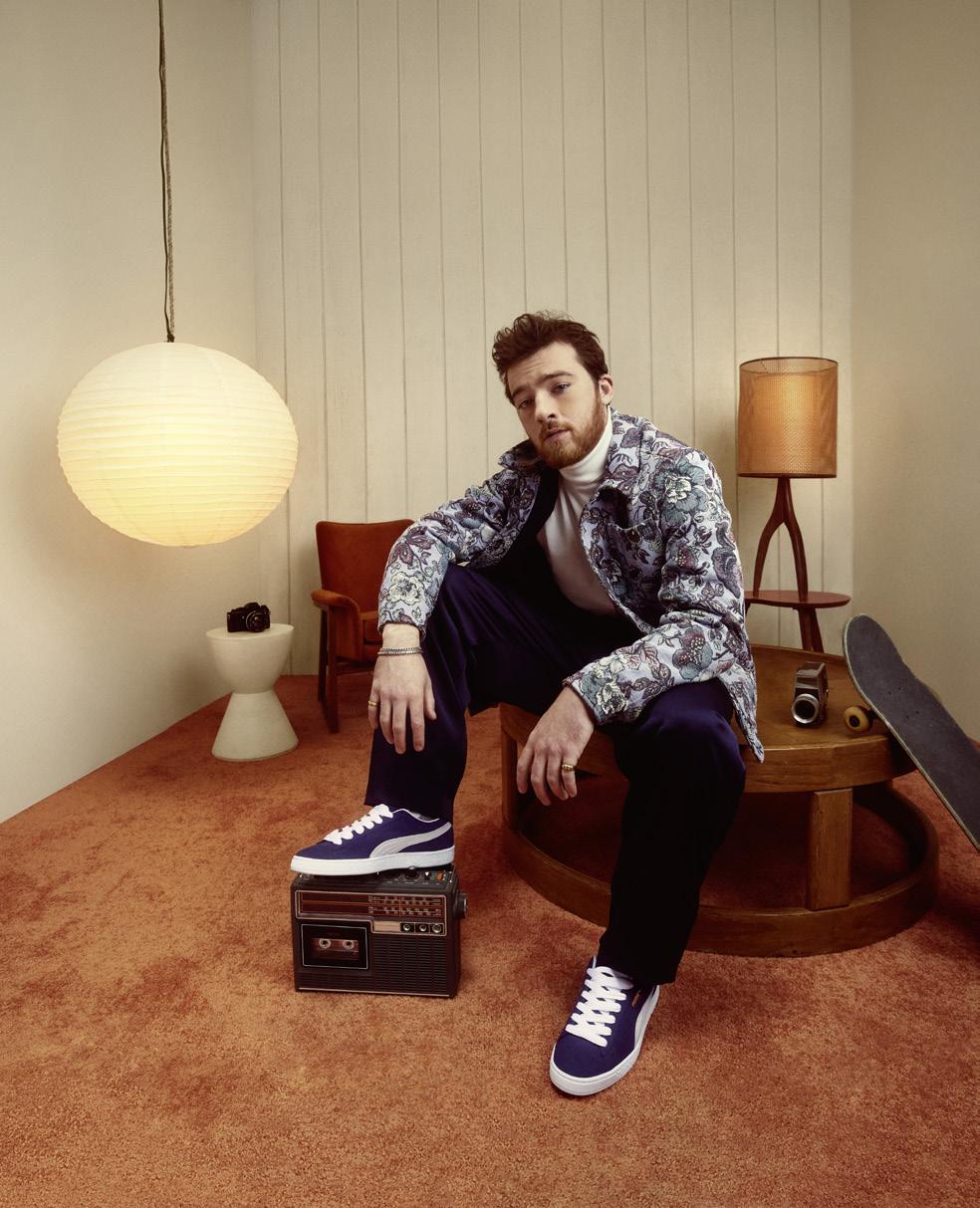
“I love PUMA’s celebration of brave, confident and determined individuals. Together we all strive to be better versions of ourselves, and this campaign is the perfect meeting of classic and individual style.” – Zaya Wade
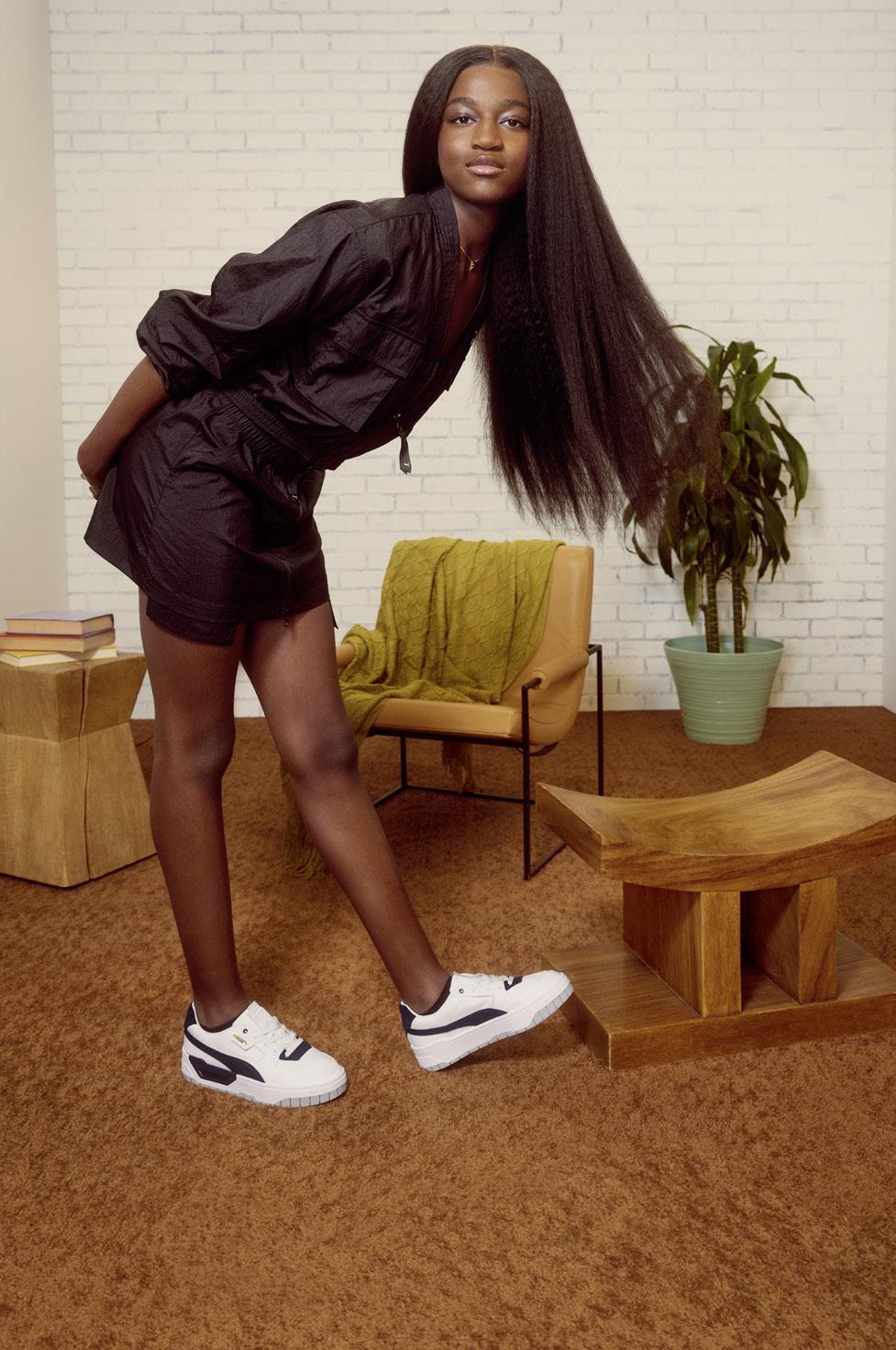
39 STYLE
Celebrates Pride2023 GUESS Watches With A Little Sparkle

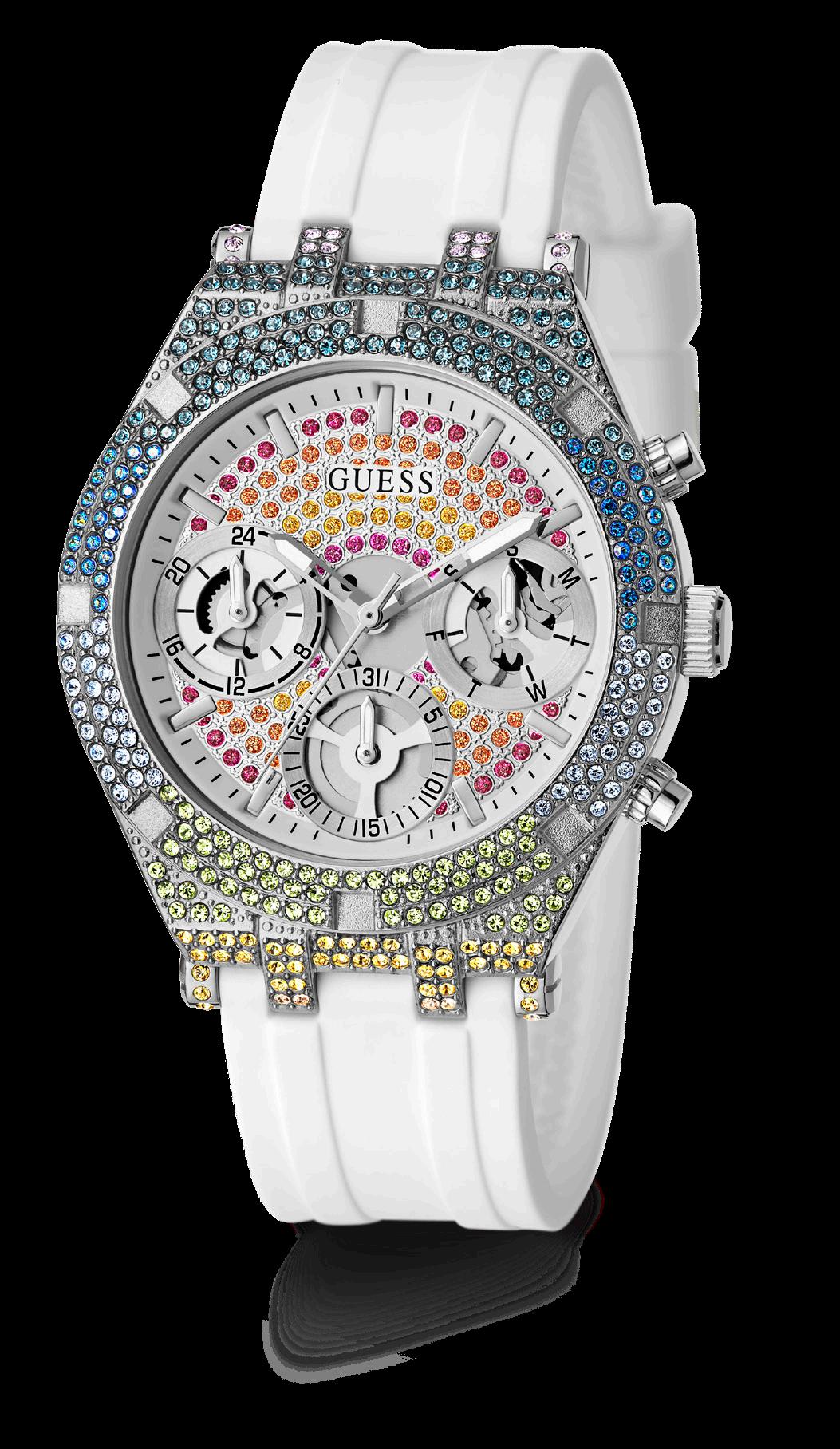
The fashion authority watch brand has teamed up with The Trevor Project and is showing its pride with the launch of its ‘What Makes You Sparkle’ limited edition timepieces
In celebration of Pride Month, GUESS Watches and The Trevor Project have created a collection of limited edition timepieces that symbolize and celebrate the spirit of social and self-acceptance. The just-released ‘What Makes You Sparkle’ capsule collection of watches all include colourful rainbow crystals injected throughout the timepieces and are the perfect accessory…whether it’s Pride day, Pride month or Pride year.
The range includes two signature styles that are sure to make anyone sparkle. The first is a 38 mm polished silver case with multi-row ombre rainbow crystals, and a unique cut-through multi-function dial (also with ombre crystals), featured on a stylish white silicone strap. It retails for $295.
The second style in the capsule is a 40 mm polished gold case with ombre crystals, including the iconic triangle featured in the cut-out dial, surrounded with a splash of coloured sparkle crystals. It retails for $135.
“We celebrate this cultural moment with our continued support for The Trevor Project and its life-affirming mission and work,” says Ann Marie Santo, the vice-president of global marketing for GUESS Watches. “Positivity and self-acceptance is what shines through with our partnership inviting all those in support of Pride today and every day to share what makes them sparkle!”
The Trevor Project was founded in 1998 and has since grown to be the world’s largest suicide prevention organization for the LGBTQ+ community. As part of the launch of the ‘What Makes You Sparkle’ capsule collection, GUESS Watches and Timex Group will donate a total of $50,000 to The Trevor Project, which will help the organization continue to provide free, 24/7 crisis services via a phone lifeline, text and chat. The donation will also support The Trevor Project’s innovative research, advocacy, public training and peer support programs, as well as scale its counsellor training to serve the more than 1.8 million LGBTQ young people who seriously consider suicide each year.
40 IN MAGAZINE MAY / JUNE 2023
STYLE
The ‘What Makes You Sparkle’ capsule collection in support of The Trevor Project is now available on Guess.com.

STYLE
 Photo by Juliette F on Unsplash
Photo by Juliette F on Unsplash

PHOTOGRAPHER: Ivan Otis
WARDROBE STYLING AND HAIR: Brian Phillips for worldSALON using WORLD Hair Skin MODELS: Austen, Finn (both from LeDrewModels)

44 IN MAGAZINE MAY / JUNE 2023 FASHION
That first touch and stars have been exploding – in your eyes I found home…

45 FASHION
LEATHER JACKET (AUSTEN LEFT): Burray Olson
LEATHER JACKET (FINN RIGHT): Ivan Lloyd Chung
JUMPER: Zam Barrett – ZFACTORIE
BELT: Ivan Lloyd Chung
GLASSES: Stylist’s own
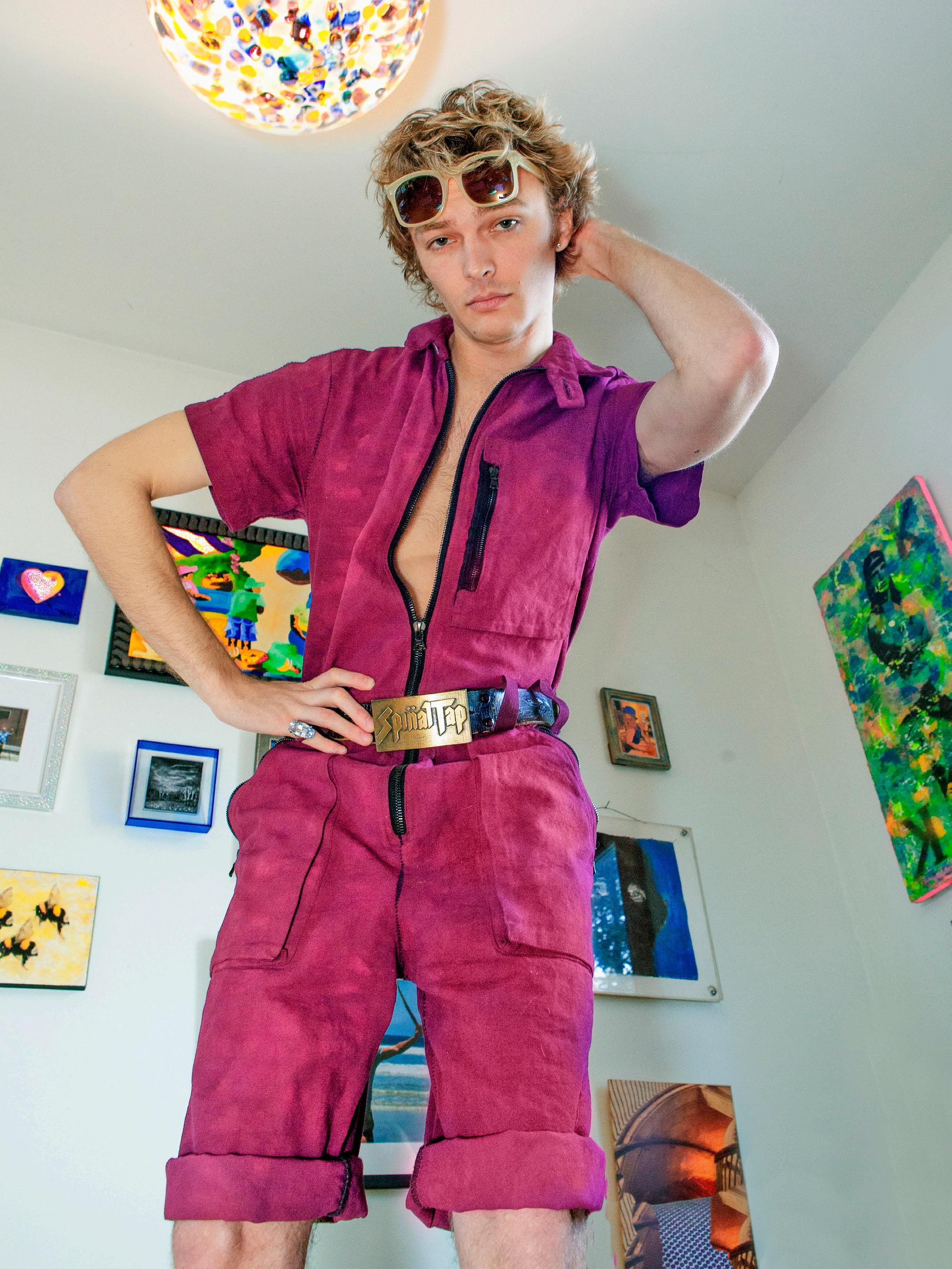
46 IN MAGAZINE MAY / JUNE 2023 FASHION

47 FASHION
ALL CLOTHING: Zam Barrett – ZFACTORIE BOOTS: Aldo

48 IN MAGAZINE MAY / JUNE 2023 FASHION
JACKET: Ivan Lloyd Chung
PANTS: Model’s own
SHRUGS: WORLDMARKET at worldSALON SHORTS (FINN): Knobs by Ryan Hill SHORTS (AUSTEN): Diesel PUPPY: Thor
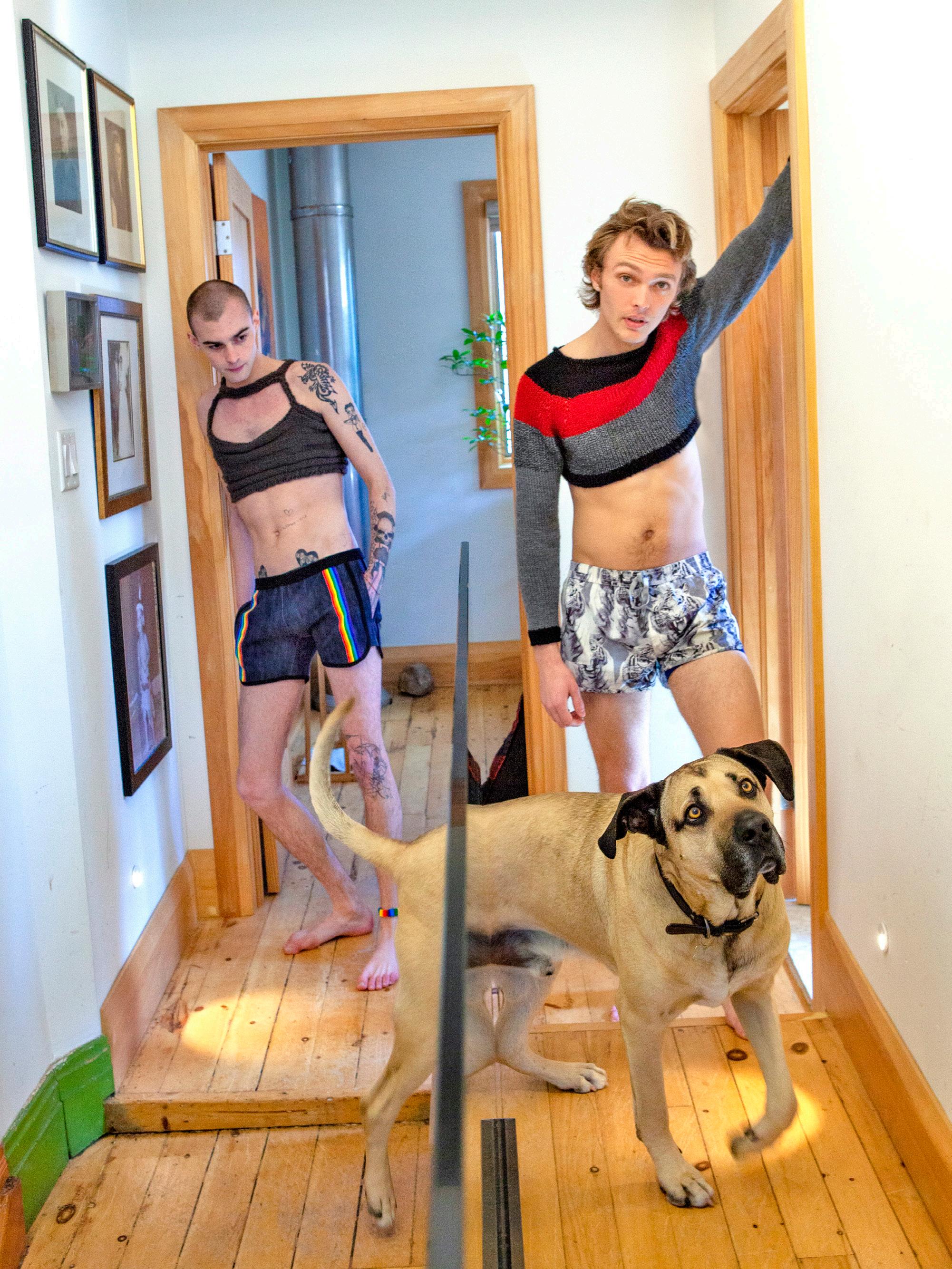
49 FASHION
LEATHER JACKET (AUSTEN): Burray Olson
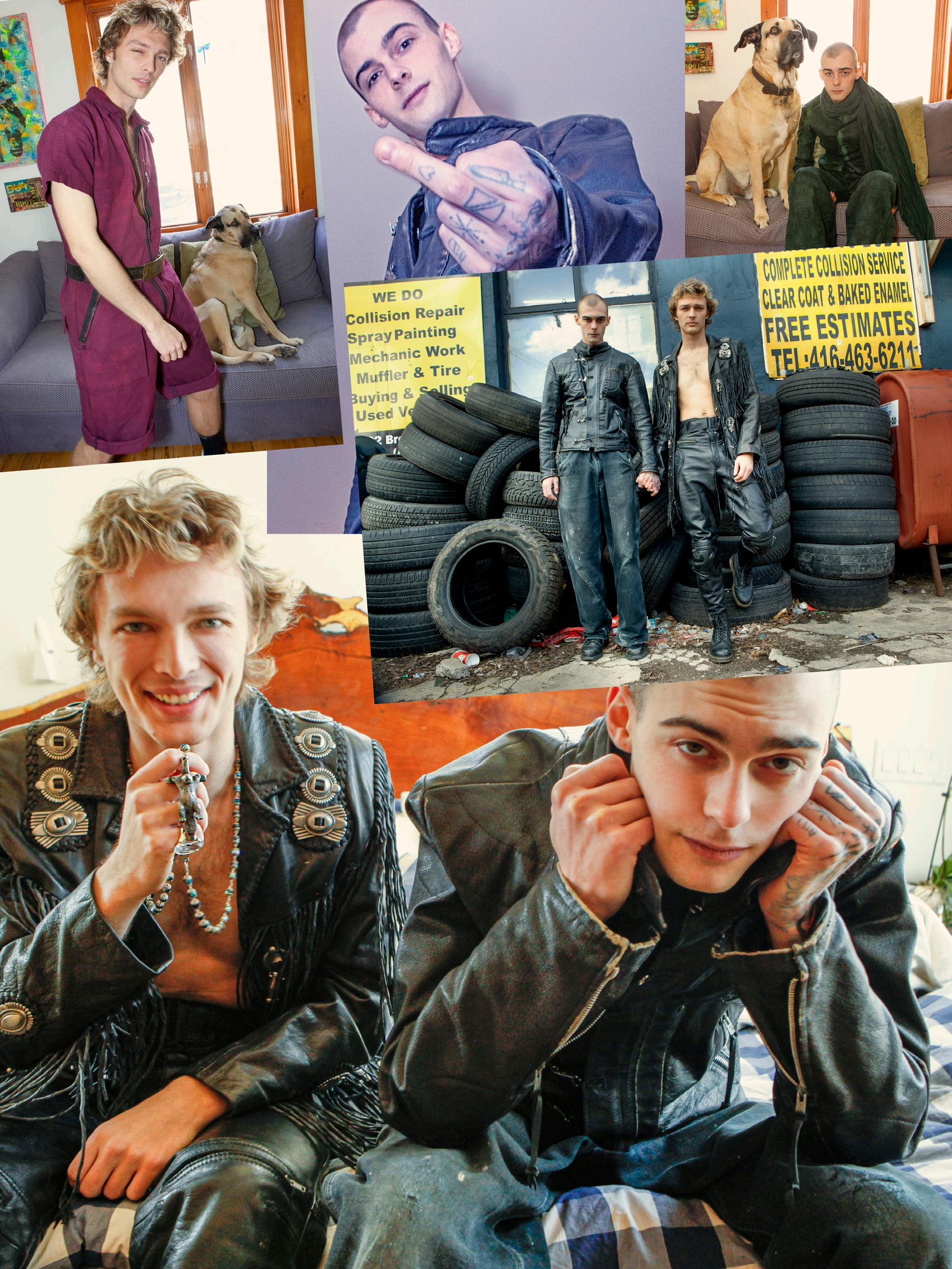
LEATHER JACKET (FINN): Ivan Lloyd Chung
BEAVER ROSARY: Kent Monkman
50 IN MAGAZINE MAY / JUNE 2023 FASHION

51 FASHION
GREEN SUIT (FINN): Zam Barrett – ZFACTORIE HAT: Goorin Bros
SHIRT (AUSTEN): Zam Barrett – ZFACTORIE SHORTS: Diesel
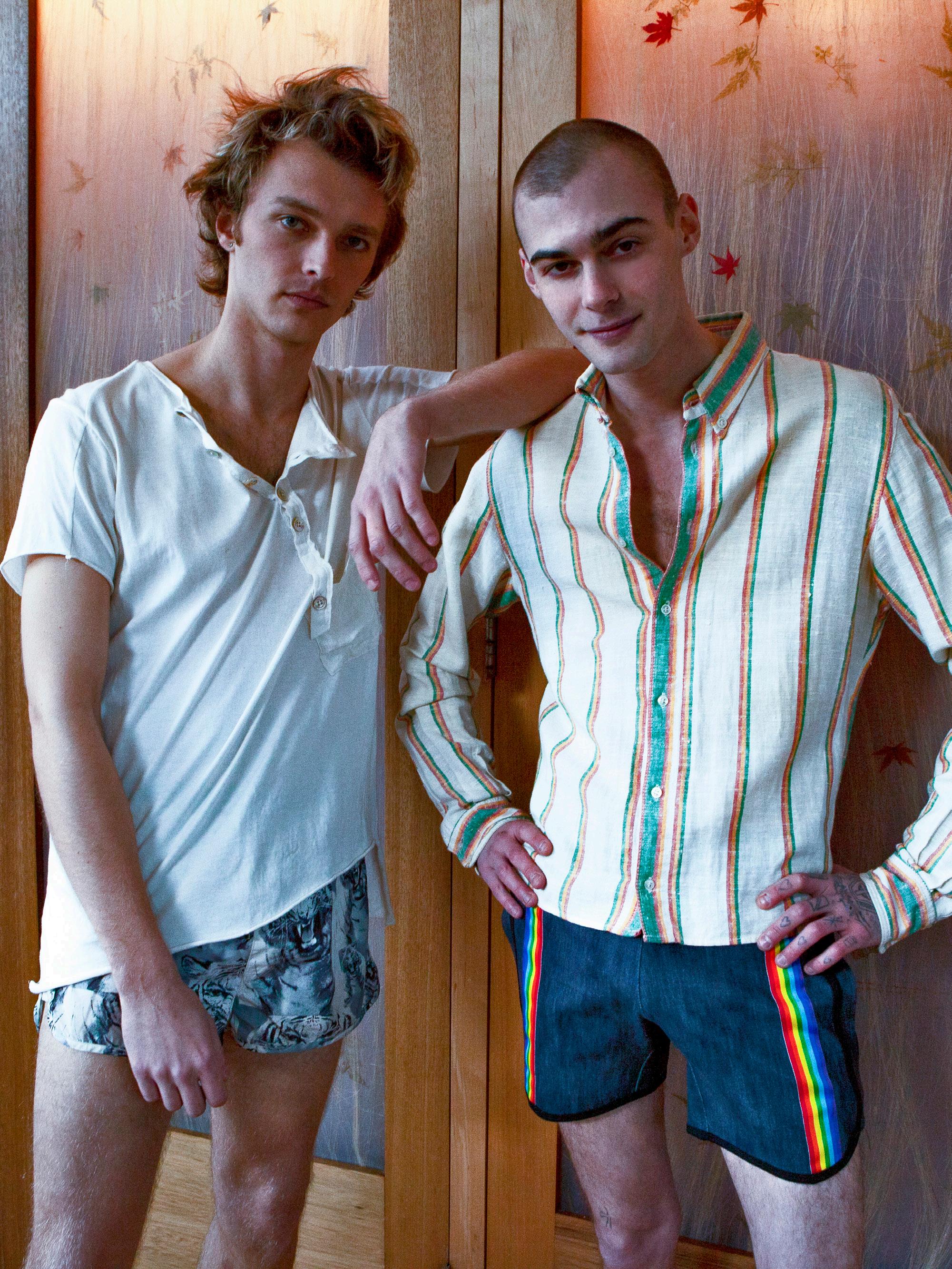
SHIRT (FINN): Ivan Lloyd Chung
SHORTS: Knobs by Ryan Hill
52 IN MAGAZINE MAY / JUNE 2023 FASHION
SUIT (AUSTEN): Dean Hutchinson – A’bout Design
SHOES: John Varvatos
SUIT (FINN): Zam Barrett – ZFACTORIE
SHOES: Aldo

53 FASHION
OUR STORIES AND IDEAS SHOW UP IN THE MOST UNEXPECTED PLACES
As part of its 50th anniversary, the Canada Council’s Art Bank prioritized purchasing work by diverse and previously under-represented artists
By Paul Gallant
Queer visual artist Melissa Doherty has been hoping to have her work purchased by the Art Bank since she began her full-time artistic career in 2000. In December 2022, Doherty received notice that the Art Bank’s peer assessment committee had selected her 2019 work, “The Green and the Grey,” which is a photographically real painting of what seems to be a hedge, the almost-plastic artificiality of it, so tightly cropped that it creates a sense of mystery and tension.
“It’s exciting for a mid-career artist,” says Doherty, who is based in Kitchener-Waterloo, Ont. “It’s a real boost for my artistic development that will help me continue what I’m doing.” Since she started pursuing art as her full-time career in 2000, Doherty’s paintings have been included in exhibitions internationally and in Canada, and one of her works is in the collection of Sir Elton John and David Furnish (although she can’t say much about that for privacy reasons, the painting could be on display in one of the couple’s California homes). Even so, the Art Bank acquisition has special resonance.
Over its 50-year history, the Art Bank has purchased the work of many significant contemporary Canadian artists, including paintings, drawings, prints, mixed-media, photography, fibre, and indoor and outdoor sculpture. It rents works from its collection of more than 17,000 pieces that together are worth almost $73 million – through a rental program that enables the works to be displayed in, say, the lobby of a government building, a corporate boardroom or other public space.
Renters benefit by being able to display work that has been endorsed by the Art Bank for its cultural significance without having to buy it outright – savvy renters might be tempted to swap out their art every couple of years, allowing a piece to make an appearance in another space, perhaps on the other side of the country. Artists benefit not just from the purchase, but from the pleasure of having their art displayed in spaces that are often busy, where workers and visitors see the work over and over again in different contexts. It’s different than being in a gallery, where you’re just one snack in a buffet.
“Lots of people see it; maybe they’re even seeing it every day for a while,” says Doherty. “They can get to know it and live with it.”
As part of its 50th anniversary, the Art Bank has prioritized purchasing the work of artists who self-identify as Indigenous, Black, racialized, Deaf or having a disability, from official language minority communities, youth, 2SLGBTQ+, gender-diverse and women, including artists at the intersections of these identities. “The Art Bank is extending its ongoing dialogue on inclusivity by celebrating the vibrancy of creators who give us such incredible depth and perspective on the arts landscape in Canada,” says Amy Jenkins, Head of the Art Bank.
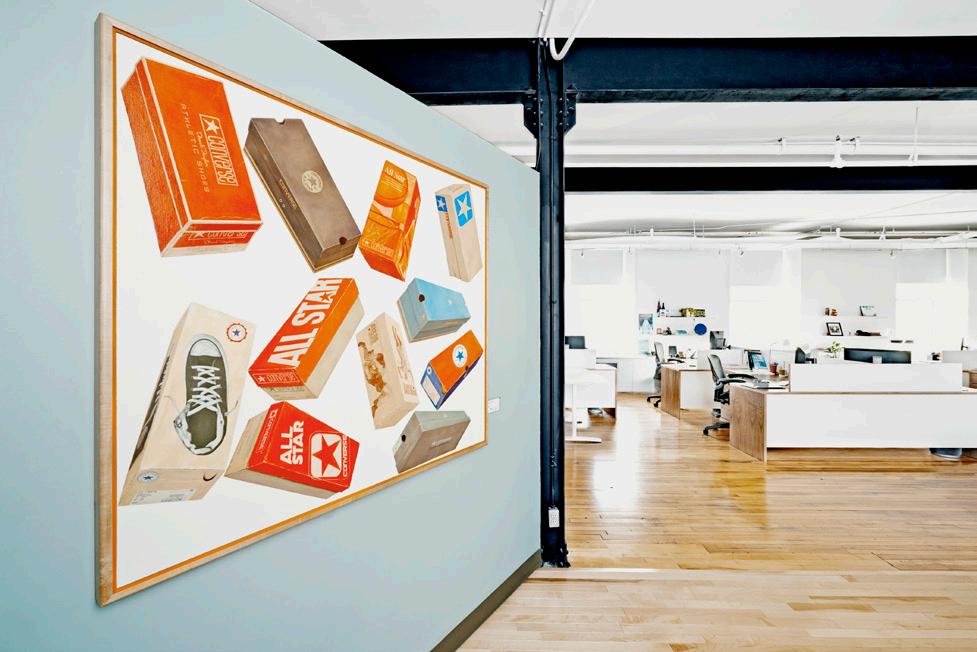
This year they bought 72 works. “A purchase of this scale means a greater number of artists are given a unique opportunity to build connections and spark meaningful conversations in new settings. This is what the Art Bank loan and rental programs are all about.”

54 IN MAGAZINE MAY / JUNE 2023
INSIGHT
Art Bank collection – rent from over 17,000 artworks
Lorenzo Pepito’s painting, “Converse: Speak” (2007), installed at an Ottawa art rental client. Photo: Lipman Still Pictures
Getting more 2SLGBTQ+ art out, perhaps in unexpected locations where it can be seen by the public, helps reframe the larger cultural conversation about queer and trans culture that was once hidden away from those who claim to be bothered by it.
Doherty identifies as a queer woman, but her human-less landscapes initially made me wonder how “queer” her paintings themselves could be, taken on their own. Talking to her, I was completely sold. Doherty spoke about coming out and how her paintings are a negotiation between “what I can show the world and what I can’t show the world.” In her artist statement, she writes: “The compulsion to paint gave me an outlet when I had no other form for expressing my real identity. I could hide behind the painting, while using a heightened realism to fabricate the realness/truth I sought. I could use a painting, which is a replication, a simulation, a virtual space…to make-believe my reality.”
Thinking of how stereotypes about gender cause us to think of a male god in the sky, with the Earth as female – man as light, woman as darkness – she painted “Cloud Witness,” an aerial view of clouds reflected in lakes. It’s a beautiful reproduction of nature, but it also turns gender on its head, merging sky with Earth. “Putting those clouds in the lake was a way of collapsing those binaries,” she says.
In this 50th anniversary round of acquisitions, a project by Brandon Hoax also made the cut. A Haudenosaunee, Onyota’a:ka (Oneida), two-spirit artist originally from London, Ont., who now lives in Nova Scotia, Hoax’s work balances “hard and soft, sensuality and clinical, the body and incorporeal to explore brown queer Indigenous yearning.” The Canada Council’s Art Bank purchase “Movemarrow Full Suite,” from 2020, is a series of nine photos of colourful harnesses Hoax created using Indigenous ribbonregalia sewing techniques. The harnesses, which reference both the fetishwear of gay culture and pow-wow regalia, were given to other urban Indigenous artists as an invitation to create an artistic

response. You could imagine someone waiting for a decision on, say, a mortgage looking at the photos and wondering if the harnesses were worn to a Pride party or a pow wow, and what kind of art might have been created to reciprocate Hoax’s gift.
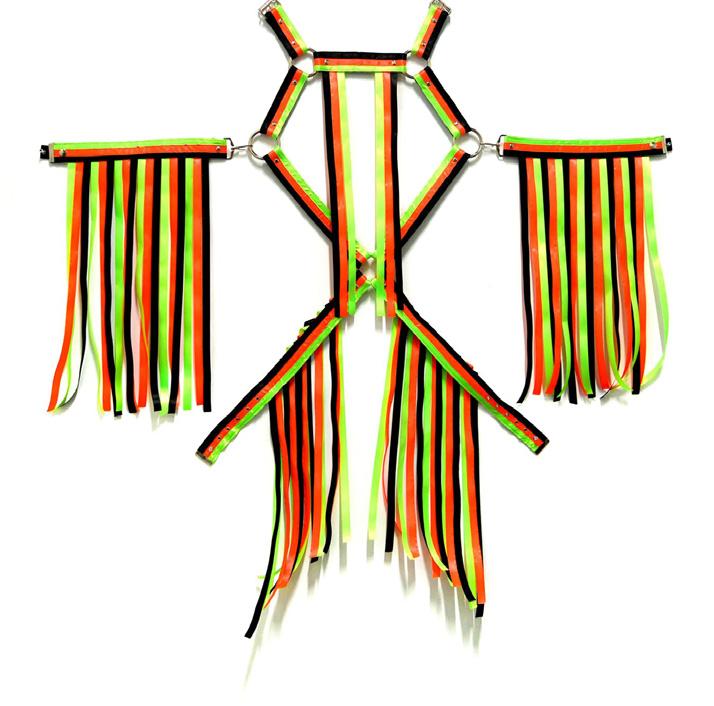
“The Art Bank has, in a way, funded the continuation of the project because I want to continue it,” Hoax tells me. “It’s fun for me to be able to make something, but the stuff that comes after is the exciting part for me, the reaction to it, the dissemination further out into the world. It helps me get the work out to a wider audience.”
Because government agencies have a reputation for red tape and being slow to change, Hoax says the fact that the Canada Council Art Bank is giving priority to under-represented artists has special significance. “The way they have joined the conversation around decolonization and equity is meaningful.”
I ask Hoax if they feel they are specially situated for the current moment, at the intersection of 2SLGBTQ+ and Indigenous culture. They’re too modest, perhaps, to answer my question directly, but say that their successes may, in effect, be passed on, just like a harness project can trigger the creation of more work. “I can understand the role I play with other two-spirit Indigenous artists, as someone who’s making it in their art career. It can be done,” they say.
The randomness of where specific Canada Council Art Bank acquired works may appear can be thrilling for artists, especially those who crave starting a conversation out there in the real world, not just in the refined world of galleries and museums. It certainly fits with Hoax’s current state of mind – finding joy where they can. “I’m trying to find joy in many things, joy as an Indigenous person, as a queer person, as someone who has survived many of the crises that I’ve been through…and of course in my art.”
The Art Bank offers unique public access to contemporary visual art from Canada through its programs – art rental, loans to museums, exhibitions, and outreach. To learn more or connect with an Art Bank consultant about the corporate art rental program, visit artbank.ca.
55 INSIGHT
PAUL GALLANT is a Toronto-based writer and editor who writes about travel, innovation, city building, social issues (particularly LGBT issues) and business for a variety of national and international publications. He’s done time as lead editor at the loop magazine in Vancouver as well as Xtra and fab in Toronto. His debut novel, Still More Stubborn Stars, published by Acorn Press, is out now.
Brandon Hoax, “MOVEMARROW” (2020) (detail), photograph. Photo: Scott Kedy
Melissa Doherty, “The Green and the Grey” (2019), painting.
Photo: Brandon Clarida Image Services
Building A Local LGBTQ+ Travel Itinerary With Grindr
Beyond finding “fun,” Grindr’s global network of 12 million monthly users can offer local LGBTQ+ recommendations and experiences for hundreds of destinations – you just need to explore
By Stephan Petar
As soon as your Grindr profile says “visiting,” the app’s distinctive notification ping starts going off. It notifies you of the locals trying to grab your attention with a “Hey,” an unlocked album or a simple “Looking?”
It’s easy to dismiss Grindr as a hookup app to find fun. While that is a common intention (I’ll admit to it), the app is also a beneficial travel tool and one I encourage others to use when planning a trip. That’s why, as soon as I exit the plane and step into Wi-Fi range, I search for the little yellow skull and change my bio to some variation of “Canadian visiting, send recommendations!”
Building an itinerary using Google or TripAdvisor can become repetitive. It can lack local and LGBTQ+ recommendations in favour of points of interest that every tourist will inevitably flock to. Of course, when in Rome, see The Coliseum where Lizzie McGuire fictionally performed “What Dream Are Made Of,” or have a staring contest with the Mona Lisa in Paris.
Finding an LGBTQ+ travel experience can be hard. If you type in “LGBTQ+ [enter destination],” you’ll easily find a rainbow crosswalk,
a queer district, clubs and sauna recommendations. You’ll even likely discover sites that are iconic to the global community or those featured in pop culture. Other than that, though, you’re really digging for any sort of LGBTQ+ experience or history, which isn’t surprising, as those stories were usually overlooked or silenced.
A Bookings.com survey revealed that 57 per cent of Canadian LGBTQ+ travellers are more likely to choose travel that allows them to learn more about the historical aspects of the LGBTQ+ community in their chosen destination. That is almost the same number (56 per cent) when compared to all respondents in the full survey, which spoke to more than 5,500 individuals in over 20 countries.
That’s where a “hookup” app like Grindr, or even Scruff, can come in handy. Before leaving, I use the Grindr Explore function (limitless access with Grindr Xtra or Unlimited, and three profile unlocks daily with the free version), and begin making connections with locals wherever I am travelling to. I recommend putting your travel dates in the profile, so they’re aware you’re not some bored Canadian looking for nudes.
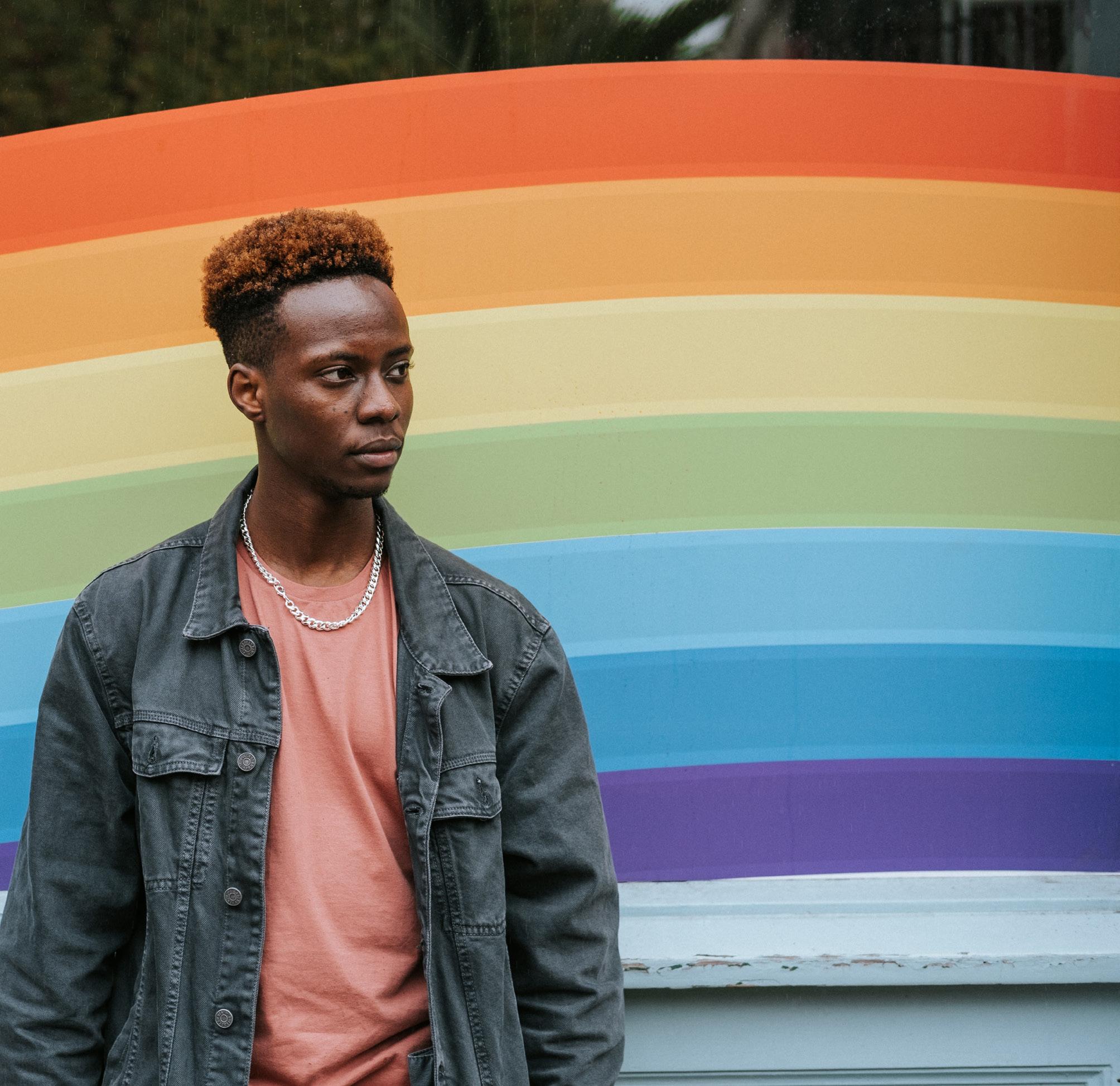
56 IN MAGAZINE MAY / JUNE 2023 TRAVEL
Photo by Anete Lusina on Pixabay
The function introduces individuals who become unofficial tour guides. They’re people who live the LGBTQ+ lifestyle at that destination and have either been part of its history or heard stories from community members about it.

They can guide you to murals, monuments or businesses; tell you where up-and-coming drag queens or kings are performing; or where local artists who are part of the community are showcasing their work. They can also likely advise on popularized points of interest that have an LGBTQ+ connection. Not to mention tell you how that club/bar that Google recommended may have played a larger role in regards to LGBTQ+ activism.
You can also get general advice and tips that are honest, because you’re speaking with people advocating for how amazing their city is. They want to be a good host and make sure you enjoy your time. So, you’ll get the details on best places to eat or drink, what to check out, when to go out, the tourist traps to avoid and more.
I’ve experienced all of this first-hand. In Iceland, I didn’t listen to the advice of tour guides or hotel staff, but rather dictated my entire food journey thanks to men on Grindr. One recommendation was to eat at a fish store where locals get their daily catch, as it had a small kitchen that serves lunch. These unofficial tour guides have led me to quieter beaches in Cascais, Portugal, where locals and their dogs relax, swim and jump off an old stone bridge. They even suggest day trips to other small overlooked towns.
The last statistic I’ll pull from Bookings.com is that 68 per cent of Canadian respondents (and 64 per cent globally) consider their safety and well-being when choosing a destination. My Belgium friend, whom I met on Grindr and largely inspired how I use the app, told me that above all, “Grindr is a social media platform, so people can recommend to you places to go that are safe and [places] that should be avoided at all costs.”
It’s especially true for those visiting places that don’t have the best LGBTQ+ track record, and for solo travellers in search of companions. Sometimes you need a travel buddy, and while websites suggest free walking tours or hostels as a way to make friends, they’re suggestions not always looked at with an LGBTQ+ lens. Coming out to complete strangers can be difficult and dangerous. This is a dilemma for many of my solo travelling friends and myself, but with any LGBTQ+ social app, you diminish that risk.
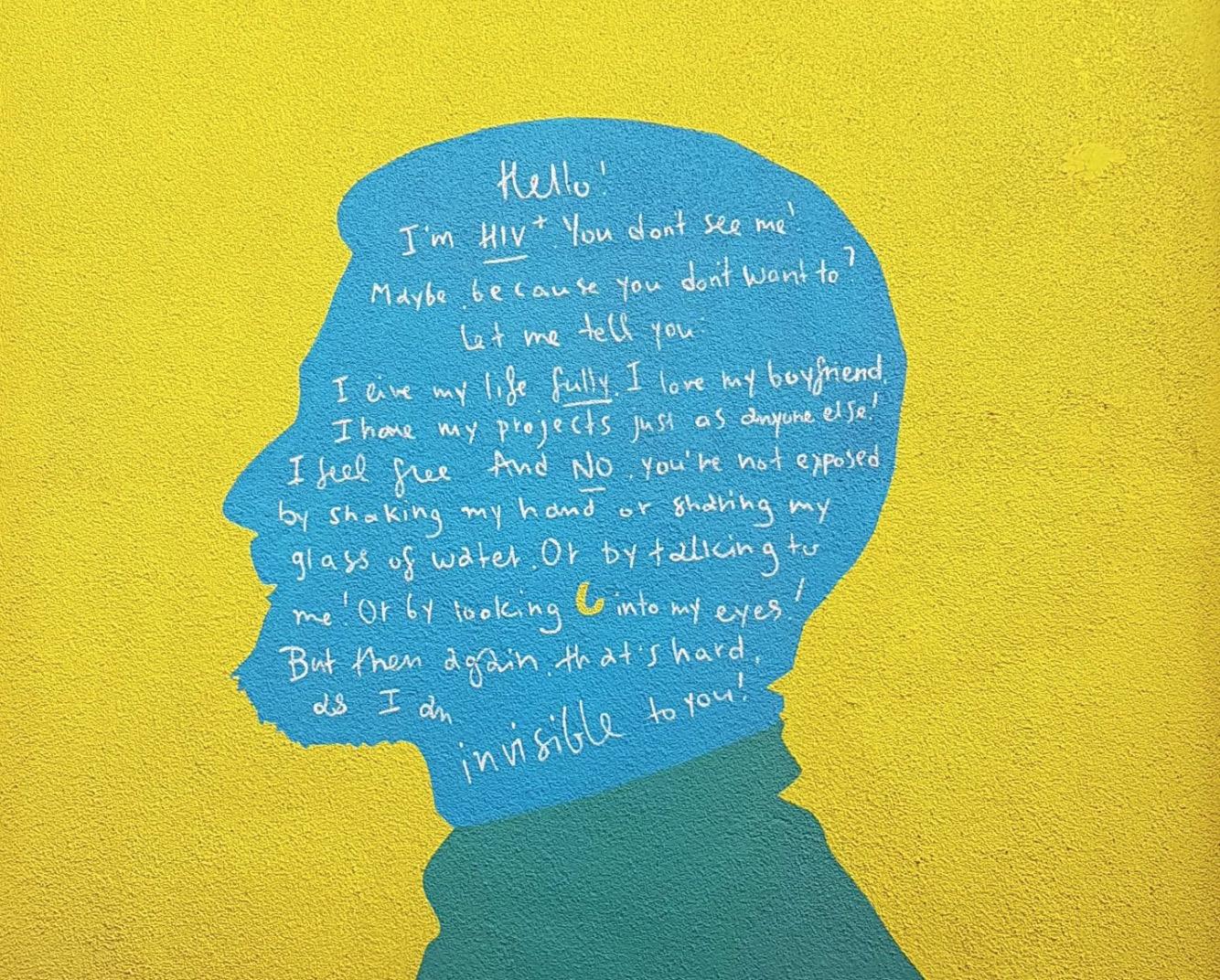
Grindr (or any LGBTQ+ dating app) is a powerful travel tool no matter what its popular reputation suggests. It’s a network creating community and providing unique experiences to broaden your knowledge that you’ll likely share with others. Just remember to pay it forward with your own recommendations when a tourist comes into town.
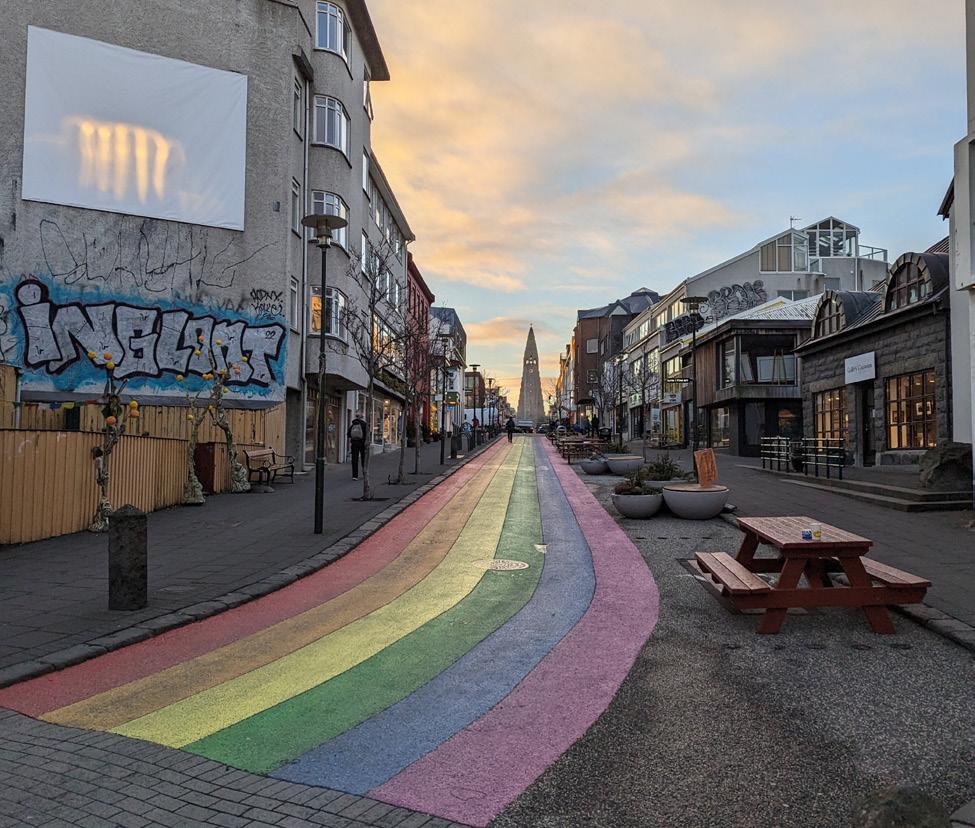

57
TRAVEL
STEPHAN PETAR is a born and raised Torontonian, known for developing lifestyle, entertainment, travel, historical and 2SLGBTQ+ content. He enjoys wandering the streets of any destination he visits, where he’s guaranteed to discover something new or meet someone who will inspire his next story.
HIV mural in Belgium. Photo by Stephan Petar
Photo by Astrobobo on Pixabay
Rainbow Street in Iceland. Photo by Stephan Petar
Axel and Eigil, T-shirts in Denmark from the first same-sex couple in the world to enter in a legal union. Photo by Stephan Petar
NiagaraWeekendFallsAway
 By Doug Wallace
By Doug Wallace
58 IN MAGAZINE MAY / JUNE 2023
of
riding the current in the Honeymoon Capital of the World is a barrel of fun, pardon the pun
A couple
nights
Photos By Doug Wallace
TRAVEL
“My ride’s here,” I say cheekily as the Niagara Helicopters pilot swings into view and touches down on the landing pad, light as a feather. I’m bloody James Bond, I think, as we head up and over to the natural wonder of the world that is Niagara Falls. What a view! I take the middle seat, of course, because I’m a martyr.
However much you think Niagara Falls is just a tourist trap, think again. Despite the saucy jacuzzi-in-the-bedroom stigma, Niagara Falls makes for an excellent weekend away, romantic or otherwise. It used to be the fudge that brought me back here time and again, particularly when out-of-towners would insist on making the trek around the Golden Horseshoe to check it off their bucket list. Now, the Niagara agenda is as long as your arm, Brenda.
You’re a tourist – act like one
Call me corny, but I never stop smiling on the Voyage to the Falls Boat Tour, formerly the Maid of the Mist. It’s just a we’re-in-this-together kind of outing. Twirling around inside the Horseshoe Falls in my plastic poncho always makes me laugh, headlining my Instagram post of the day.

We can almost – but not quite – hear the screams of everybody on the boat later on, while watching it from our perch on the new falls viewing platform, which opened last summer. It’s at the end of a long tunnel, once used to move water out of the old Niagara Power Station, which opened in 1905 and was decommissioned in 2006. Appropriately called The Tunnel, it’s the newest project of Niagara Parks, which recently converted the whole station into a museum. The museum does double duty: when the day tours are over, it transforms at night into an immersive sound-and-light show that hinges on the history of the building and its place in the story of electricity. It’s while wandering around the station that I notice how handsome Serbian-American inventor Nikola Tesla was, which leads to an online search for his boyfriends. (Asexual!)
After the show, we walk into the neon part of town where the night is still young, all haunted houses, arcades and guilty-pleasure food. We amble into a pod of the Niagara SkyWheel, Canada’s biggest at 53 metres, and relax looking out over both falls – all lit up as they are each night. We can see the river, the skyline, the go-karts screaming around the rollercoaster-style speedway, the mini-golf course with a dinosaur that growls every few minutes – this is kid’s stuff, but it’s fun. You could have sex in the SkyWheel but you’d have to make it quick. And be alone.
An appetite for bon appétit

Happily, Niagara Fall’s culinary highlights are well worth the trip all on their own. At Reds steakhouse in the Fallsview Casino, I find a dining experience that straddles the fence between old-school and new-style. We take our time deciding on the sides that will go with our prime rib, because they had me at “cabernet jus.” The meal is seriously good.
Up in Orchard Park, the oyster champions at Tide & Vine are still winning awards, included in OpenTable’s Top Restaurants in Canada listings. The Mollica family at Casa Mia Ristorante are still going strong after 30 years of serving Italian classics, three generations on. I love Italian restaurants that let you just “add meatballs” to a pasta bowl of something delicious, like you were curating the perfect, personal dish. Flour Mill Restaurant, set within the turn-of-the-century Old Stone Inn, turns out artisanal everything. High tea is an exercise in indulgence, the macarons and petit fours duly fine, ditto the skewered bacon drenched in maple syrup.
The confections in Niagara Falls are also award-winners. Maple Leaf Place provides a guided taste-testing of its Ontario maple syrup mere steps away from where it is bottled, and the same goes for CFX Chocolates, which makes the most exquisite red chocolate-covered cherries. You are going to need more than a half-hour in each of these places – just make sure you’re not hungry or you’ll end up with a backseat full of sugar.
And let’s not forget the trunk full of wine. You would be remiss not to visit a few Niagara wineries, all on a relatively beaten path. Custom
59 TRAVEL
tours can pick you up and drop you off no trouble, so you don’t have to drive, which is key. Take note of the nearby family-owned Ravine Vineyard Estate Winery, which is one of the top winery restaurants in Canada. We tuck into family-style platefuls of house-cured and -smoked charcuterie and local cheese, tomato-and-bread salad, braised short ribs and Erie pickerel, then roll into the van with a few bottles of their brut fizzy to take home.
It’s a walk in the park
North of town, my phone dings to say, “Welcome to the United States. You’re roaming!” Nope, I’m just wandering the 40-hectare grounds of the Niagara Parks Botanical Gardens, which opened in 1936. It’s famous for its rose garden, which contains almost 2,500 blooms. The nearby Butterfly Conservatory is pure magic, home to more than 2,000 butterflies that flit among the exotic flowers, trees, ponds and waterfalls of their little dome. It feels a bit like The Truman Show. And by the looks of their little plates of fruit, butterflies are the slowest eaters ever.


Farther down the river, a stop at Queenston Heights Park brings us to the Landscape of Nations, a memorial to the Haudenosaunee (Six Nations) Confederacy and Native Allies for their critical contributions to the winning of the War of 1812. Eight limestone walls are arranged in a Memory Circle here, around a bed of sweetgrass – a peaceful spot to re-examine the core of Canadian history.
While you’re up in this neck of the woods, keep going north for one more touristy indulgence: the Whirlpool Jet Boats. No, you don’t have to get wet like the pictures; you can stay dry by piling into the dome-covered seats. We head out to cut doughnuts around the Class 5 rapids of the Niagara Whirlpool. These are natural rapids not caused by rocks but by the massive flow of water leaving the Niagara Gorge. Yes, there’s a little “Do you want to go faster?” schmaltz, but the tour guide is fun. He actually catches me trying to take a surreptitious picture of him mid-voyage in his little track suit – I immediately feel guilty. Why didn’t I just ask him to smile in the first place?


60 IN MAGAZINE MAY / JUNE 2023 DOUG WALLACE is an international travel and lifestyle writer, photographer and custom-content authority, principal of Wallace Media and editor-publisher of TravelRight.Today. He can be found beside buffet tables, on massage tables and table-hopping around the world.
TRAVEL

“A QUEER, WITCHY THRILLER” DEADLINE GET 30 DAYS FREE mubi.com/inmagazine A FILM BY LÉA MYSIUS ON MUBI MAY 12
FLASHBACK
Pride Flag Raised On Canada’s Parliament Hill For The First Time (June 1, 2016)
To kick off Canada’s first-ever nationwide Pride Month, and for the first time in Canadian history, the rainbow-coloured Pride flag was raised on Parliament Hill in Ottawa by Prime Minister Justin Trudeau on June 1, 2016.
“This is a great day for Canada and it’s part of a long series of milestones this country has hit over the years. It hasn’t been easy, it hasn’t been automatic. A lot of people fought for a long time for this day to happen,” Trudeau said at the time, after he had the distinct honour of raising the distinctive flag.
“Canada is united in its defence of rights and it’s standing up for LGBTQ rights,” Trudeau said, noting that politicians from all the parliamentary parties – not just his own Liberal MPs – were in attendance. “And quite frankly…we still have more work to do,” he said, adding that his government
was pushing a transgender rights bill to extend protections to trans Canadians.
At the Ottawa event, Trudeau announced that he would be marching in Toronto’s 2016 Pride parade, the first time a sitting prime minister had taken part in any Pride festivities in Canada.

“It’s not going to be my first time,” Trudeau said to laughs from the crowd about his upcoming attendance. (Trudeau has been a regular at Pride in past years; he actually launched an election campaign the previous August at Vancouver’s Pride parade.)
A year later, on June 1, 2017, history was made yet again when the Transgender Pride flag was raised on Parliament Hill.
62 IN MAGAZINE MAY / JUNE 2023
Photo by Joy Real on Unsplash
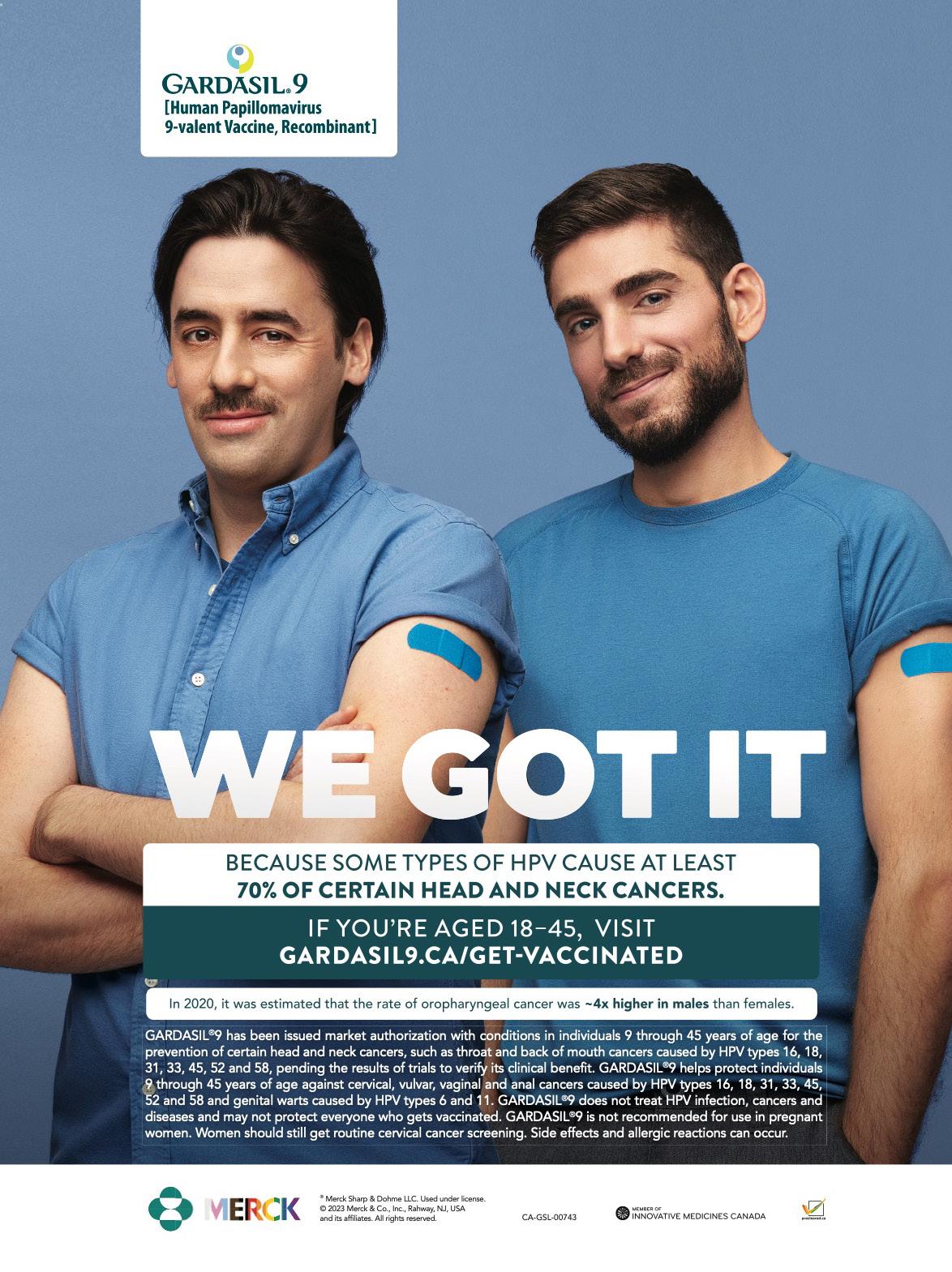

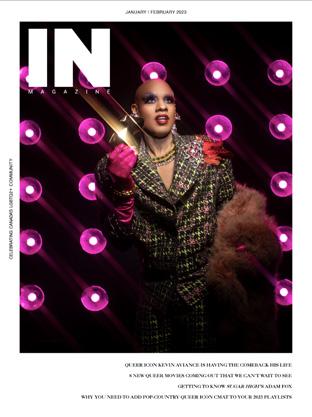
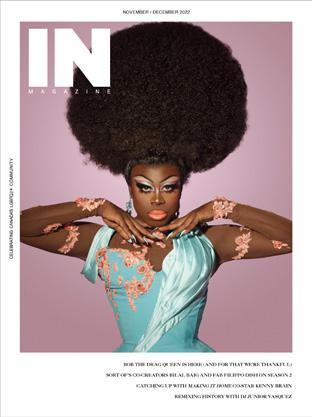




64 IN MAGAZINE MAY / JUNE 2023 inmagazine.ca INMagazineCA PUBLISHED BI-MONTHLY ONLINE CONTENT EVERY DAY IN MAGAZINE IS CANADA’S LEADING 2SLGBTQI+ DIGITAL PUBLICATION, WEBSITE AND COMMUNITY PLATFORM
























 By Courtney Hardwick
By Courtney Hardwick



 By Luis Augusto Nobre
By Luis Augusto Nobre





 By Jumol Royes
By Jumol Royes








 By Warren Urquhart
By Warren Urquhart
 By Elio Iannacci
By Elio Iannacci


















 Photo by Juliette F on Unsplash
Photo by Juliette F on Unsplash




















 By Doug Wallace
By Doug Wallace















